Frontiers of Computing
USC’s $1 billion-plus “moonshot ” initiative will create a new school of computing, establish a Silicon Beach campus and reimagine tech.

FOR ALUMNI AND FRIENDS OF THE UNIVERSITY OF SOUTHERN CALIFORNIA AUTUMN 2023 $4.95
scene
The USC beach volleyball team won its third straight NCAA championship (sixth national title and fifth NCAA crown) on a 3-2 win over top-seeded and No. 1-ranked crosstown rival UCLA at Gulf Shores, Ala., on May 7.

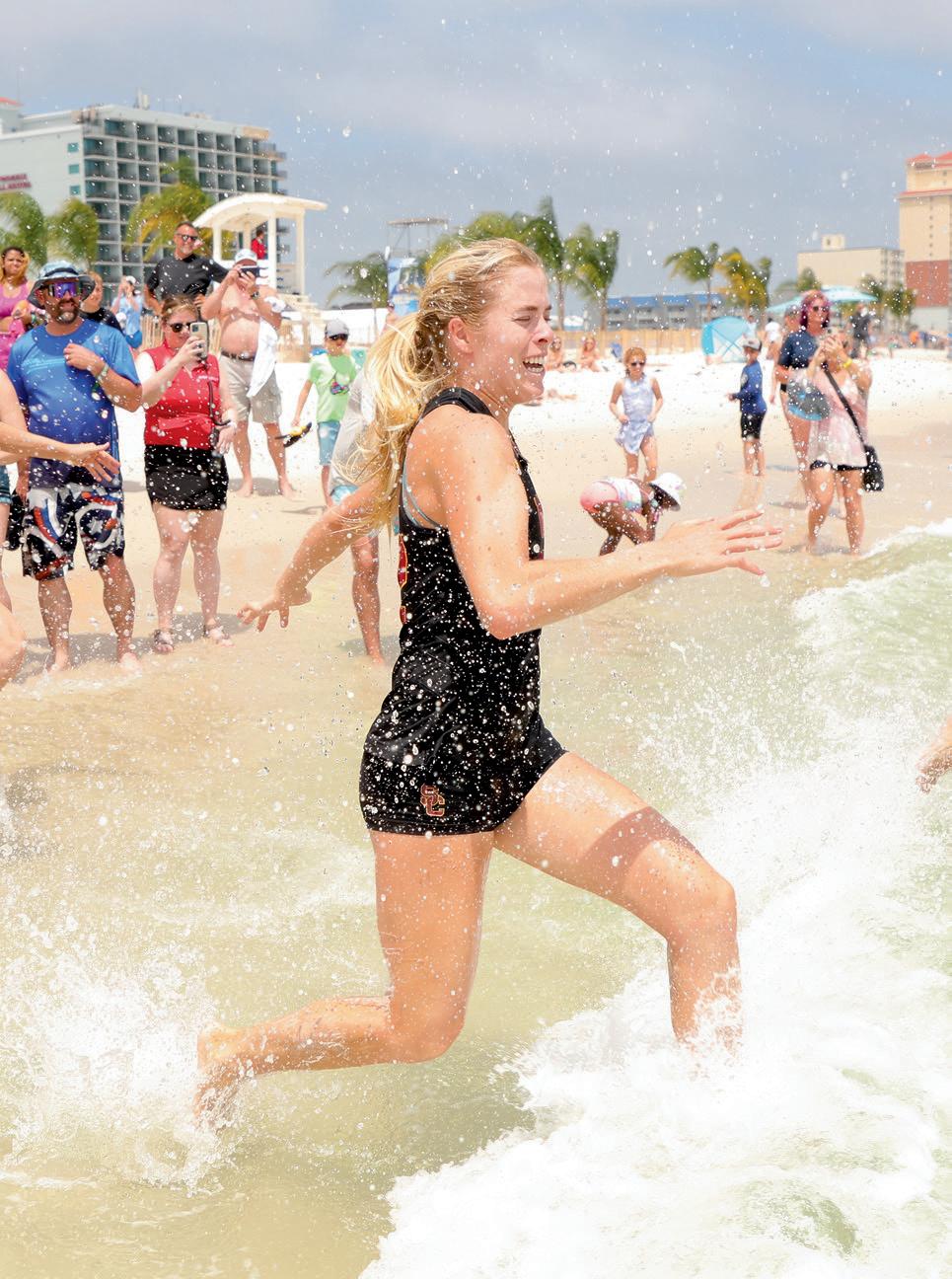
C. MORGAN ENGEL/NCAA PHOTOS VIA GETTY IMAGES
The magazine of the University of Southern California
EDITOR-IN-CHIEF
Ted B. Kissell
CREATIVE DIRECTOR
Jane Frey
MANAGING EDITOR
Lilledeshan Bose
ASSOCIATE EDITOR
Chinyere Amobi
COPY EDITOR
Cord Brooks
PRODUCTION MANAGER
Mary Modina
VISUALS EDITOR
Damon Casarez
STAFF PHOTOGRAPHER
Gus Ruelas
Pushing Boundaries
In the field of advanced computing, USC has always set big goals — and then exceeded them. After all, the university helped build the first networked computers, awards the most computer and information science degrees of any research university, and is the birthplace of such famous combinations of letters as .com, JPEG and VoIP.
Now, USC is poised to turn even more technological acronyms into household names. In May, USC President Carol L. Folt announced the launch of Frontiers of Computing, a $1 billion-plus initiative that will push the boundaries of computing, advance human inquiry through cutting-edge technologies, and produce the next generation of tech and computing leaders.
At the heart of Folt’s Frontiers of Computing “moonshot” is the launch of the new USC School of Advanced Computing, the university’s 23rd school (and first since 2013). Our cover story in this special issue of USC Trojan Family Magazine details the opening of a Silicon Beach Campus within the booming tech corridor on the Westside of Los Angeles, building on USC’s tradition of excellence in computer science to become a multidisciplinary hub for the university’s technological ecosystem.
That story is one of several features in this issue that explore the power and potential of advanced computing at USC. Read on to learn how one faculty member pairs Trojan imagination with science in conceiving smart buildings and how others interrogate the trustworthiness of AI.
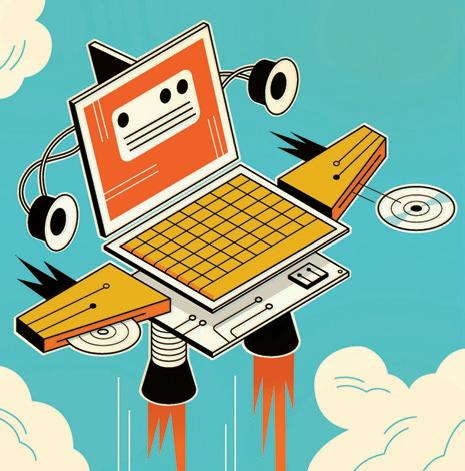
Our editorial team at TFM created this special issue in close collaboration with our colleagues at USC Viterbi Magazine; the list of their talented staff and contributors appears on this page. We’re thrilled to share their expertise in telling computing-centered stories with you.
Read on to learn more about the future of … the future.
Ted B. Kissell
Editor-in-Chief USC Trojan Family Magazine
INTERACTIVE CONTENT
MANAGER
Edward Sotelo
INTERACTIVE
MARKETING MANAGER
Anna Clark
DESIGN AND PRODUCTION
Pentagram
CONTRIBUTORS
Chloe Barker
Ron Mackovich-Rodriguez
David Medzerian
In Collaboration with USC Viterbi School of Engineering
USC Viterbi Magazine
EDITOR
Adam Smith
MANAGING EDITOR
Marc Ballon
ART DIRECTOR
Madelin Lum/James Kim
STAFF WRITERS
Julia Cohen
Greta Harrison
SOCIAL MEDIA
Amy Blumenthal
USC Trojan Family Magazine 3434 S. Grand Ave., CAL 140 Los Angeles, CA 90089-2818
magazines@usc.edu | (213) 740-2684
USC Trojan Family Magazine (ISSN 8750-7927) is published in March and October by USC University Communications.
MOVING? NEW EMAIL? Update your preferences at trojanfamily.usc.edu/subscribe.
ADVERTISING: Visit trojanfamily.usc.edu/advertise for information.
2 usc trojan family Autumn 2023 COVER ILLUSTRATION BY JOSH COCHRAN; ILLUSTRATION BY HARRY CAMPBELL
EDITOR'S NOTE
,
4 Seen and Heard
The truth about the Alamo, student films at Cannes and more.
USC Frontiers of Computing is a $1 billion-plus initiative to fast-track developments in advanced computing. (More on p. 20.) Learn more about the USC Frontiers of Computing initiative.
7 News
USC’s
12
47 Alumni News
Happy 100th birthday to the USCAA; the 89th annual Alumni Awards; and a footballer’s dream.

64 Fight Onward
20
A New Frontier
With a new School of Advanced Computing and a campus in Silicon Beach, USC is leading the charge to apply high-tech solutions to the world’s biggest challenges.
By Marc Ballon and Paul McQuiston
26 SCilicon Beach
A look at places where USC is making its mark in the world of tech. By Adam Smith
28 USC,s Big Wins
From quantum computing to robotics to machine learning, these seven innovations established USC on the frontiers of computing. By Adam Smith
32
The Places That Built Me
Professor Burçin Becerik-Gerber imagines a life with “smart” buildings. By Adam Smith, Illustration by Yuta Onoda

40 Ifs, Ands, and Bots
Artificial intelligence can solve many problems — while creating new ones.
By Grayson Schmidt
42
Transplant Trailblazer
A USC doctor is on the verge of performing the world’s first human bladder transplant.
By Rachel B. Levin
usc trojan family trojanfamily.usc.edu 3 ILLUSTRATION BY RAY BIESINGER; PHOTO
MCGILLEN/USC ATHLETICS INSIDE
BY JOHN
T R O J A N
5 Five Things You Need to Know Trojans are celebrating 100 years of the L.A. Memorial Coliseum.
new athletics director, natural carbon capture in the ocean, surfing pain away and more.
Live, Invent, Learn Scientific polymath Scott Fraser has a special talent for invention and exploration.
F A M I L Y
18 Brain Food Research on Indigenous Bolivian populations can teach us how to eat for brain health.
F E A T U R E S
Women’s soccer and lacrosse are getting a new stadium.
The Whole Story of the Alamo: Good, Bad and Ugly
While visiting Thomas Jefferson’s Virginia plantation, Monticello, on a research trip, doctoral candidate Kate Rogers of the USC Rossier School of Education was struck by a small handprint in a brick wall — probably left by a child, one of the more than 400 enslaved people who helped build the grand house. Teachers in Rogers’ group pressed in close to take pictures and vowed to share them with students when the topic of slavery arose.
That confirmed for Rogers “the power of place” in preparing teachers to teach history — especially contested history. “Giving teachers the language and tools to open up a real dialogue with students, versus just getting them to memorize
dates and facts, is so important,” says Rogers, executive director of the Alamo Trust in San Antonio. “Historic sites and museums can help support teachers at a time when they desperately need it.”

Today Rogers oversees a $450 million Alamo redevelopment plan, which has stirred impassioned debate. Traditionalists want to focus on the heroism of those who fought for Texas’ freedom. But others have pressed for recognition of the Indigenous people who built the Alamo for Spanish missionaries and acknowledgment that Alamo defenders were fighting in part to uphold their rights as enslavers.
Rogers says she is committed to telling the complete 300-year history of the site the good, the bad and the ugly. “Our big goal,” she says, “is to push visitors to think about things they hadn’t considered before because the story is more complicated than it has traditionally been told.”
ELAINE WOO
START SPREADING THE NEWS
Plenty of theater students travel to New York City to attend Broadway productions. But a weeklong trip by second-year MFA acting students from the USC School of Dramatic Arts took the experience to a significantly higher level, including behind-the-scenes access to top Broadway shows and rehearsing in one of the city’s most storied venues.
The eight students rehearsed their next production at Atlantic Theater Company, just as professional actors would. They also attended the critically acclaimed revival of Arthur Miller’s Death of a Salesman and met afterward with the principal cast,
including McKinley Belcher III, a USC 2010 MFA graduate.
The trip had its genesis in New York City last year when USC President Carol L. Folt and Dean Emily Roxworthy of the School of Dramatic Arts attended a performance of Death of a Salesman. “We were both blown away by the production, which was a true master class in acting,” Roxworthy says.

Kaixiang Zhang, a member of the acting cohort, says that rehearsing every day in a New York City theater rehearsal space “makes me feel like I’m a professional actor right now.”
ALLISON ENGEL
USC STUDENT FILMS WIN AT CANNES

Films from students at the USC School of Cinematic Arts have again been recognized as standouts among the 38 official selections in The American Pavilion’s Emerging Filmmaker Showcase at the Cannes Film Festival. The “festival within a festival” has become an important event for student filmmakers beginning their careers.
Fathead was recognized as the Best Student Short Film. The dystopian short follows its heroine who takes on an army of children after they kidnap her brother. Fathead was directed by c. Craig Patterson ’20; produced by Mitchell Graham Colley, Anthony Gaitros, Letia Solomon, Alexa Villarreal and Brandyn Johnson; and staffed by a team of 122 USC alumni.
Waves Apart explores the antisemitic roots of surfing; it took Best Student Documentary honors. It was directed by Josh Greene ’22 and produced by Aslan Dalgic and Ela Passarelli. Greene grew up surfing in Orange County. At his bar mitzvah at the San Clemente Surfing Heritage and Culture Center, his parents had to rearrange the decor to move historic surfboards engraved with swastikas out of sight.
BENJAMIN POLA
4 usc trojan family Autumn 2023
Filmmakers Josh Greene ’22 (from left), Jacqueline Elyse Rosenthal ’23 and c. Craig Patterson ’20.
SEEN AND HEARD PHOTO COURTESY OF KATE RODGERS; PHOTO COURTESY OF USC SCHOOL OF CINEMATIC ARTS; PHOTO BY ALFRED MAGALLANES S T A Y I N T O U C H Follow Us @uscedu Tweet Us @TrojanFamilyMag Like Us University of Southern California Email Us magazines@usc.edu Write Us 3434 S. Grand Ave. CAL 140 L.A., CA 90089-2818
USC School of Dramatic Arts students and faculty meet the cast of the Broadway revival of Death of a Salesman
Everyone has a story about the L.A. Coliseum — and we’d love to hear yours! Email us at magazines@usc.edu to tell us what made your Coliseum experience so special.
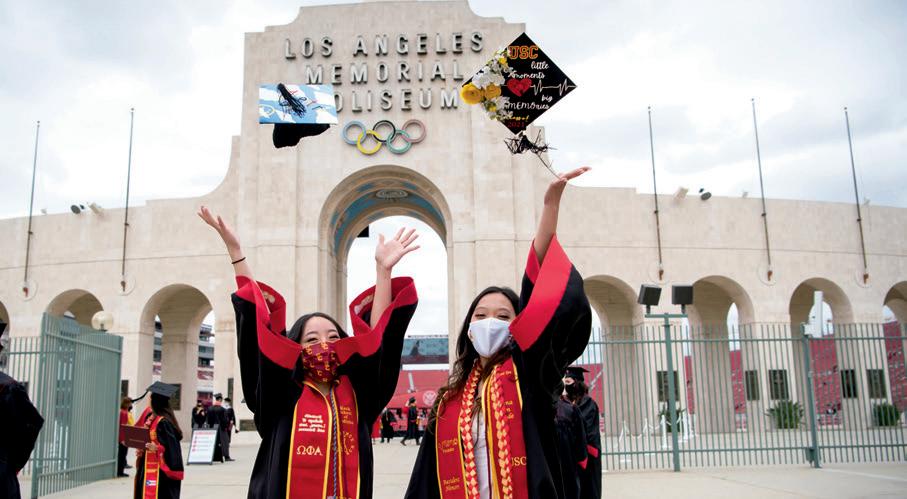
Trojan Fortress
USC and the Los Angeles Memorial Coliseum have an entwined history and future: The Trojans’ proximity was a big reason the Coliseum was built across Exposition Park, and USC’s lease agreement there runs until 2111.
And while the Coliseum has hosted the World Series (1959), the Super Bowl (1967 and 1973) and the Olympic Games (summer 1932 and 1984), as well as world leaders such as Franklin D. Roosevelt (1935), Martin Luther King Jr. (1964), Pope John Paul II (1987) and Nelson Mandela (1990), it’s the Cardinal and Gold that gives the Coliseum its heart. Need proof? Just read on.
OFFICIALLY HISTORIC
The Coliseum is one of only four college football stadiums with National Historic Landmark status (the others are the Rose Bowl, Harvard Stadium and the Yale Bowl).
TRADITION REVIVED
During the COVID-19 pandemic, the Class of 2020 and Class of 2021 celebrated commencement at the
BEGINNING BLOWOUT
The complex has been home to the USC Trojans since the first game was held on Oct. 6, 1923. In the blowout vs. Pomona College, the Trojans won 23-7, with 12,836 people in attendance.
THE COMEBACK
In November 1974, USC beat rivals Notre Dame 55-24 by scoring 55 points during 17 minutes of the third quarter. Sports Illustrated called it the “17 minutes that shook L.A.” Almost 50 years later, the game is still celebrated as one of the greatest comebacks in college football history — and for decades held the record for the most points ever scored on Notre Dame in a single quarter.
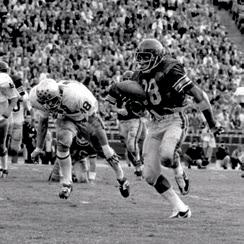
SHARING WITH THE ENEMY
For half a century (19331982), the Coliseum was also home to USC football rival UCLA. Before the Bruins moved
FIVE THINGS
NEED TO KNOW
YOU
USC VS. NOTRE DAME PHOTO COURTESY OF USC ATHLETICS; USC COMMENCEMENT PHOTO BY GUS RUELAS

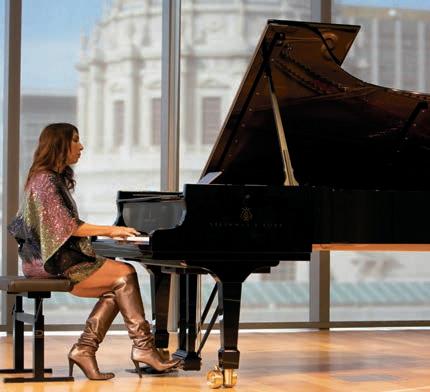
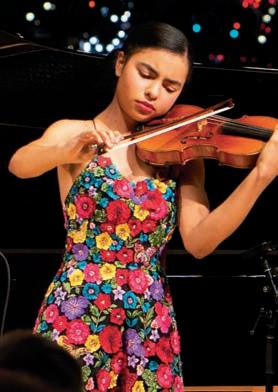








more than 75 years, we have been nurturing a love of classical music for all, from Los Angeles to San Francisco and cities in between. Learn how to support us by visiting KUSC.org and KDFC.com Find out about our events, programming highlights, developing talent and membership.
the #1 classical radio network in the country? Enjoy locally curated classical music by scanning these QR codes to download our free app! Or stream us online! KUSC
For
A Broadcast Service of USC Did you know that USC operates
LOS ANGELES KDFC SAN FRANCISCO
TROJAN
WEST GOES EAST

The USC Trojan Marching Band performs across from the Washington Monument at the Lincoln Memorial to celebrate the opening of the USC Capital Campus in Washington, D.C.

usc trojan family trojanfamily.usc.edu 7
PHOTO BY BRETT PADELFORD
Tums for the Ocean
Scientists are working to mitigate the rising levels of carbon dioxide in our atmosphere with calcium carbonate.
Scientists around the world are racing to develop new methods for combating the rising levels of carbon dioxide in our atmosphere that are driving climate change and threatening the health of our planet.
One promising method is ocean carbon capture, which involves using natural ocean processes to trap and store greenhouse gases at sea. Professor of earth sciences, environmental studies and spatial sciences William Berelson of USC Dornsife College of Letters, Arts and Sciences and Jess Adkins of Caltech are working together to harness this technology and address the problem.
HOW DO CARBON EMISSIONS AFFECT OUR OCEANS?
Berelson: As carbon dioxide from the atmosphere dissolves in ocean water, it increases its acidity thus causing ocean acidification. The rising annual rate of CO2 emissions leads to a corresponding increase in ocean acidification, resulting in dramatic impacts on marine
BY NINA RAFFIO
ecosystems like corals and other organisms that use calcium carbonate to build shells. People care about corals for their beauty, but these organisms are also crucial to biodiversity and sustaining the populations of fish and other marine life that live in and among the coral communities.
Adkins: Another reason we should care about ocean acidification over and above the photographic megafauna like corals is the algae out in the middle of the ocean and far away from the coast. They are the primary producers and bottom of the marine food chain where sunlight is first turned into organic matter and then becomes food for the rest of the system, humans included.
HOW DOES THE OCEAN NATURALLY CAPTURE CARBON?

Adkins: The planet has been capturing carbon for billions of years. As the ocean absorbs excess carbon, the CO2 reacts with calcium
carbonate, or limestone, that naturally occurs at the sea floor — this reaction makes the neutral salts of bicarbonate and calcium ions.
Berelson: The natural reaction that happens in the ocean is exactly what happens when you treat an upset stomach. The analogy we like to use is that when you have excess acid in your tummy, you take a little antacid tablet, which is effectively ground up calcium carbonate, to neutralize the acid.
WHAT ARE YOU WORKING ON NOW?
Berelson: An idea came about during our research on how the ocean naturally mitigates excess CO2. We discovered that if we could accelerate the dissolution of limestone, it could be a way to mitigate CO2 at a larger scale. We’re developing a startup company that could one day build machinery that would allow this reaction to happen at a fast enough scale and at the right quantity to make a greater impact on CO2 reduction.
8 usc trojan family Autumn 2023 PHOTO BY GIGA KHURTSILAVA VIA UNSPLASH trojan news
Surviving Liver Cancer
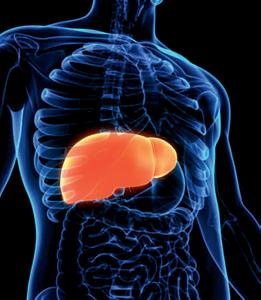
New research shows immigrant adults with liver cancer in the United States have higher survival rates than native-born patients.
Bigotry and Bile
Researchers analyzed Twitter with AI, and found that hate has increased overall since Elon Musk bought the social media site.
Computer scientist Keith Burghardt has been studying social media for five years at the Information Sciences Institute, a research institute at the USC Viterbi School of Engineering. For the last year, he’s specifically focused on online hate.
Immigrant adults with liver cancer in the United States have higher survival rates than people with the disease who were born here, according to new research from the USC Norris Comprehensive Cancer Center.
Hepatocellular carcinoma (HCC), the most common form of liver cancer, contributes to more than 27,000 deaths annually in the U.S. Immigrants make up a significant portion of those diagnosed with HCC in this country. Research has shown that birthplace, also referred to as nativity, affects incidence and risk factors for HCC, but little was known about its influence on survival after diagnosis.
The study identified a previously unrecognized disparity in survival after a diagnosis of liver cancer across all major racial/ethnic groups, with immigrants having better survival compared to those born in the U.S. This study is one of the first to robustly address nativity status as a predictor of overall survival for adults with HCC and provides important estimates of HCC survival by region of birth.
“This finding is important as liver cancer rates are rising among U.S.-born; understanding why immigrants have better outcomes may help us create strategies to improve the survival of those born here,” says study author Kali Zhou, a member of the Cancer Epidemiology Program at the USC Norris cancer center and a transplant hepatologist specializing in the treatment of chronic liver disease at Keck Medicine of USC. “This was true across different racial/ethnic groups.”
HINDE KAST
His paper “Auditing Elon Musk’s Impact on Hate Speech and Bots” quantifies hate and bots on Twitter (now known as X). Burghardt’s team hypothesized that hate speech on Twitter would increase following Musk’s acquisition in October 2022 and set about quantifying that by creating a group of words they could determine as hateful to monitor.

“Our aim was to find words that were relatively high precision, meaning that if
people are using these words, it’s unlikely they’re being used in a non-hateful manner,” Burghardt says.
Using this methodology, the team extracted timelines of a sample of users who posted hateful tweets before and after Musk’s purchase and measured their daily rates of hate speech during the same time period. They found that the proportion of hate words in hateful users’ tweets increased after Musk bought Twitter. The average daily hate speech of hateful users nearly doubled.
Burghardt’s research aims to understand influence, predict users’ engagement in hate groups and explore how external events shape extremist views.
JULIA COHEN
usc trojan family 9 trojan news LIVER ILLUSTRATION BY ISTOCK; ILLUSTRATION BY DAVID PLUNKERT
Surfing the Pain Away
Researchers are scanning pain patients’ brains after they catch waves — and constructing a virtual reality surfing experience.

Associate Professor Jason Kutch of the USC Division of Biokinesiology and Physical Therapy developed chronic pelvic pain in his 20s, a condition that eventually became “debilitating and impactful.” But when he moved to Los Angeles in 2008 as a postdoctoral researcher in biomedical engineering, he took up surfing and made a huge discovery: After he spent time in the ocean surfing, his pain would subside. Intrigued, Kutch set out to study the therapeutic effects of surfing in a rigorous manner. Thanks to a Southern California Clinical and Translational Science Institute Multidisciplinary Pilot Grant, Kutch and colleagues Associate
Breathing Easier
A USC study provides evidence that a simple biofeedback practice reduces levels of Alzheimer’s-associated amyloid beta peptides.
The exercise was simple: Inhale for a count of five, then exhale for a count of five. Do that for 20 minutes, twice a day, for four weeks. These brief breathing sessions had significant impacts: Volunteers’ heart-rate variability increased during each exercise period, and the levels of peptides associated with Alzheimer’s disease circulating in their blood decreased over the four weeks of the experiment.
That’s the finding of a study from Professor Mara Mather of the USC Leonard Davis School of Gerontology. Published in March 2023 in the journal Scientific Reports, the study may be the first to discover that adults, both young and old, can reduce their amyloid beta peptide levels in their blood via breathing exercises. This could affect their likelihood of developing Alzheimer’s disease.
BREATH WORK
The way we breathe affects our heart rate, which in turn affects our nervous system
and the way our brain produces proteins and clears them away, Mather says.

While we are awake and active, we typically use our sympathetic nervous system. “It’s called ‘fight or flight,’ but it’s really important for any sort of effort,” she says. “Wake up, get out of bed, think hard, make a presentation, even make memories — for any of that we need that system.”
While the sympathetic nervous system is activated, there isn’t much variation in the time between each heartbeat, Mather explains. In contrast, when the parasympathetic system is activated, heart rates increase during inhaling and decrease during exhaling.
“The parasympathetic is called ‘rest and digest,’ and it’s really important for repair and rest,” she says. When the parasympathetic system is activated, the variation between heartbeats is greater.
ABOUT THE STUDY
The study involved participants performing
Pr ofessor James Finley and Gabilan Assistant Professor of Computer Science
Heather Culbertson will be able to study how surfing affects chronic pain sufferers both in the water and on a complex virtual-reality wave.
The team aims to understand what effect surfing has on the brain and create a detailed virtual reality setup to replicate surfing’s benefits. By studying the neural signaling and dynamic environment of surfing, they hope to provide new options for chronic pain relief and expand access through virtual reality technology.
KATHARINE GAMMON
biofeedback exercises twice a day for 20 minutes, focusing on increasing heart-rate variability (HRV) through slow-paced breathing. The researchers found that plasma levels of amyloid beta 40 and 42 decreased in participants who practiced slow breathing and increased HRV. The results suggest that slow-paced breathing could be an effective and low-cost intervention to reduce amyloid beta levels and potentially mitigate the risk of Alzheimer’s disease. CONSTANCE SOMMER
10 usc trojan family Autumn 2023 ILLUSTRATION BY DAN PAGE; ILLUSTRATION BY NEIL WEBB trojan news
A Hub of Grub Data
Food delivery apps can be more than just a convenience. For researcher Abigail Horn of the USC Viterbi School of Engineering, delivery apps and online menus are a big-data goldmine that can provide a detailed map of the nutrition of Angelenos.

Horn, a research assistant professor in the Daniel J. Epstein Department of Industrial and Systems Engineering at the USC Information Sciences Institute,
studies how data can increase our understanding of eating behavior, diet and health. Her latest work aims to build a map of the nutritional quality of the urban foodscape in Los Angeles, using machine learning to analyze information on digital menus for all restaurants, from top-100 chains to small mom-and-pop operations.
Her research is centered on identifying where healthy and unhealthy food outlets are located — with a particular focus on
where unhealthy outlets are clustered in the city. These areas are often known as food swamps — neighborhoods with a high concentration of low-quality fastfood outlets, liquor stores and convenience stores and a lower concentration of fresh food outlets and grocery stores.
By analyzing the data with machine learning techniques, Horn aims to identify disparities in food access and inform public health research. Traditional measures of food environment nutritional quality often oversimplify the categorization of food outlets, considering limited-service restaurants as indicators of poor nutritional options. Horn’s research considers the diversity of nutritional quality within and across these c ategories.
As the project expands, Horn says, “It would be wonderful if it could help inform policy around rezoning in neighborhoods and help to create quantified metrics of where we have disparities and the true nutritional quality of food outlets.”
usc trojan family trojanfamily.usc.edu 11 trojan news ILLUSTRATION COURTESY OF ABIGAIL HORN
New USC Viterbi research harnesses online menu data to draw a detailed nutrition map of the city. BY GRETA HARRISON
A map of the Los Angeles food environment shows more nutritious options clustered in more affluent areas.
An Explorer Through Invention
Scientific polymath Scott Fraser has a special talent for live imaging of microscopic organisms — among a multitude of skills.
Scott Fraser was the type of kid who liked to take apart his toys to see how they worked. Later, as a young man, he worked alongside his carpenter grandfather in Pasadena.
This early, hands-on physics and engineering experience served him well when he began working in labs. Today, the USC Provost Professor and director of science initiatives and director of the Translational Imaging Center has a hand in a dizzying array of research endeavors — and a special talent for live imaging of microscopic organisms.
A die-hard do-it-yourselfer, Fraser has
BY LEIGH HOPPER
repurposed everything from eyelashes (as a microscalpel) to airport baggage scanners (to create his lab’s first low-light level microscope) to get a better view of the tiniest biological specimens.

This kind of adaptation and invention of tools is a major part of classical embryology: How else do you discover that a human eyelash is just right for teasing apart the cells of a frog embryo?
“We’re most happy trying to do the experiments that everybody assumes are impossible, or figuring out how to make them less impossible,” Fraser says.
“We love helping reinvent what’s impossible.”
This year, Fraser marked a decade at USC after 21 years at Caltech. And while his list of scientific publications, citations and patents keeps growing — he was named to the National Academy of Inventors in 2016 and the National Academy of Medicine in 2020 — his most influential contribution to science may be his work as a mentor and collaborator.
At least 120 trainees have passed through his labs at USC and Caltech, with several of them currently pursuing scientific careers at USC, Harvard University, Stanford University, Children’s Hospital Los Angeles and other prestigious institutions. Unlike many labs where departing members become competitors, at Fraser’s lab, scientists are encouraged to take their projects with them.
Fraser — a lifelong tinkerer — knows that it takes more than fancy lab equipment to fuel innovation. His first major purchase when he started his lab at Caltech was a restaurant-grade espresso machine. As a tool to foster collaboration, its usefulness exceeded his wildest dreams.
“In the first years of that coffee machine, there must have been two dozen patents filed,” Fraser says.
Like the late oceanic scientist Jacques Piccard, Fraser is an explorer through invention. While Piccard built deep-sea ships to explore untouched realms, Fraser builds microscopes and other tools to expand what we can actually see.
One notable achievement involved filming a live zebrafish forming a memory using
a custom-made microscope and fluorescent markers with Don Arnold and other collaborators at USC. For a recent, Harvard-led paper published in Science, Fraser helped answer long-standing questions about the left-right differences in organ development in zebrafish embryos.
For Fraser, these mysteries are what drew him to embryology in the first place. As an undergraduate, he had been a physics student with a specialty in developing low-noise electronics and deploying vibration control. He thought optics would be a tool, not a huge part of his future. But then, as a grad student, he made the “mistake” of looking through a friend’s microscope and seeing a frog embryo.
“It was a moment — I guess you call it an epiphany — but it was phenomenal to see the cells develop, to watch how after a microsurgery the cells could heal so quickly.”
Fraser had so many questions. And the answer to many of them was, “We don’t know.”
“And that,” he says, “seemed fantastic.”
12 usc trojan family Autumn 2023
trojan news
“It was phenomenal to see the cells develop, to watch how after a microsurgery the cells could heal so quickly.”
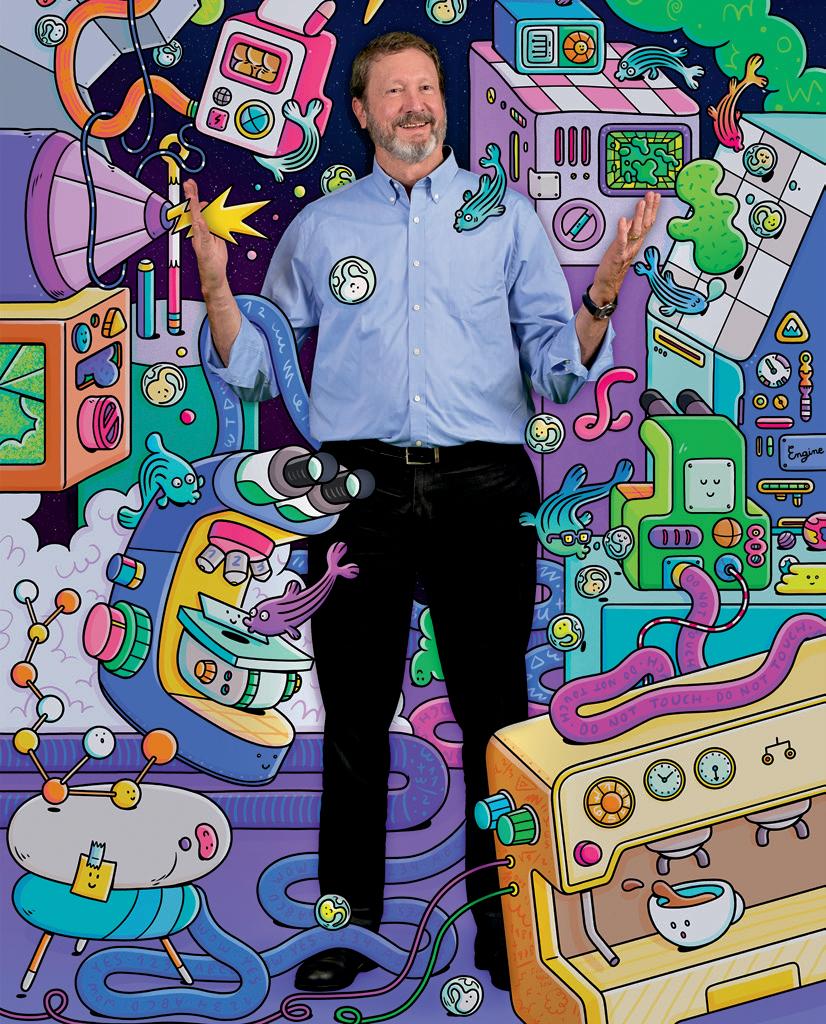
usc trojan family trojanfamily.usc.edu 13 ILLUSTRATIONS BY
trojan news
BROSMIND; PHOTO BY GUS RUELAS
Oscars Past and Present
Two groups at USC are looking back at the history of the Oscars and looking ahead to making future awards more inclusive.
In March, the Adobe Foundation awarded a grant of $250,000 to the USC School of Dramatic Arts’ MFA Acting Program, which will directly support the production of short films by underrepresented students.

The MFA Acting Film Initiative at the School of Dramatic Arts is a yearlong capstone project within the program, in which acting students develop their craft and vision as multifaceted creators.
Also in March, the Annenberg Inclusion Initiative announced a partnership with the Adobe Foundation to produce “The Inclusion List,” a new research effort tracking inclusion across the entertainment industry. The first report from the project examines inclusion from 1929 — the first of 95 Academy Awards ceremonies — to the present day, charting nominations for women and people of color across 19 categories.
Published on the web (www.inclusionlist. org), the study allows users to understand how gender and race/ethnicity across those
19 categories have changed over time. The full analysis of Oscars history uncovered that only 17% of nominees were women, 6% were people of color, and less than 2% were women of color.
Looking at 2008 to 2015 — eight years before April Reign sent the tweet that launched the #OscarsSoWhite viral call-to-action — 8% of nominees were from an underrepresented racial/ethnic group. From 2015 to 2023, however, that number grew to 17%.
“This comprehensive look at the Oscars demonstrates that exclusion was normative for many years and still is in some categories,” says Stacy L. Smith, associate professor of communication and founder of the Annenberg Inclusion Initiative. “But it also shows that there is power in collective action, and that power has ensured that the years since #OscarsSoWhite do not look like the years that came before.”
A Racial Gap
Black patients with arterial plaque buildup in the legs are more likely to have a stroke, heart attack or amputation than white patients.
A new study from Keck Medicine of USC has uncovered significant racial disparities in the diagnosis, treatment and outcomes of peripheral artery disease (PAD) among Black and white patients in the United States.
PAD, which affects approximately 8 to 12 million Americans and is associated with nearly half of the 150,000 yearly amputations in the U.S., is a potentially life-threatening condition in which the arteries that carry blood from the heart to the legs narrow or become blocked by the buildup of fatty plaque. This can lead to a heart attack, stroke or amputation of the affected limb.
“We discovered that Black patients are nearly 50% less likely to receive vascular interventions to potentially restore the blood flow than white patients, and consequently are at a disproportionately higher risk of a stroke, heart attack or amputation,” says David Armstrong, a podiatric surgeon specializing in limb preservation with Keck Medicine and an author of the study. “Additionally, Black patients tend to have more advanced PAD and are sicker at the time of diagnosis, indicating they may not be getting as timely medical attention as their white counterparts.”
Armstrong and his colleagues used a large national database to compare rates of diagnostic testing, treatment patterns and outcomes after diagnosis of PAD among commercially insured patients in the United States from 2016 to 2021. They identified some 455,000 white patients and 96,000 Black patients. They then compared demographics, markers of disease severity and health care costs as well as patterns of medical management and rates of amputation and cardiovascular events among the two patient groups to reach their conclusions. MARGARET CRABLE

14 usc trojan family Autumn 2023 trojan news ILLUSTRATION BY MELINDA BECK; USC SCHOOL OF DRAMATIC ARTS MFA FILM INITIATIVE PHOTOS BY IAN DOOLEY
PHOTO COURTESY JOHN MCGILLEN/USC ATHLETICS; ILLUSTRATION BY JOSH COCHRAN
PHOTO BY DANIEL SWARTZ
Capital Improvements
USC establishes new campus in Washington, D.C.
BY GRAYSON SCHMIDT
In April, the nation’s capital began to look a bit more cardinal and gold: USC officially became bicoastal with its new Capital Campus in Washington, D.C.

“We’re founding USC’s new Capital Campus here on the belief that a great nation requires great research universities,” USC President Carol L. Folt said at the opening celebration. “We’re bridging from coast to coast — bringing our 22 diverse undergraduate, graduate and professional schools here to more fully join the conversation.”
The USC Capital Campus, located in the Dupont Circle neighborhood at 1771 N S t. NW, places USC at the center of political and academic policy discussions while connecting the university to embassies and diplomatic outposts.
The campus will bring USC’s academic prowess to the East Coast and provide students with a space to pursue new programs
in disciplines such as the sciences, arts, education, political science, communication and journalism.
“As a major research university, our faculty’s expertise can have direct relevance to and even shape — federal policy,” says Dana Goldman, dean of the USC Price School of Public Policy.
Goldman went on to point out how the 2018 bipartisan bill that outlawed pharmacy gag clauses — clauses that prevent pharmacists from telling customers when they can save money by paying cash for their prescriptions — was based on research from the USC Schaeffer Center for Health Policy & Economics. Additionally, Peter Kuhn from the USC Dornsife College of Letters, Arts and Sciences was among the select advisers who met with President Joe Biden to discuss how to cut the cancer death rate in half over the next 25 years.
“There is no substitute for the personal interactions with lawmakers, staffers and regulators that can now take place with greater frequency and depth thanks to this magnificent new campus,” Goldman says.
USC Trustee Fred Ryan, former publisher of The Washington Post, called the USC Capital Campus “the Trojan embassy” and referred to USC as a global institution.
In addition to providing a state-of-theart office space, multiple event venues and an outdoor terrace offering panoramic views of the D.C. skyline, the 60,000-square-foot building will also be the new home for the USC Office of Research Advancement, which has helped faculty researchers secure federal funding for multidisciplinary research projects since 2006.
USC leaders hope the campus will serve as a hub for Trojans past, present and future. With the opening of the USC Capital Campus, the university plans to increase outreach to the region’s high school and community college students, and current students will have the opportunity to participate in high-level conversations with national and global opinion leaders on the most pressing issues of the day. The campus will also serve as a center for the roughly 6,000 Trojan alumni who live and work in the area, connecting them to their alma mater on the other side of the country.
“We’re eager to work on the biggest issues affecting our country: prosperity, security, innovation and sustainability,” Folt says. “Our students and faculty have always been participants in the discoveries and decisions that matter to humanity — and I think we can agree: What happens in D.C. matters.”
usc trojan family trojanfamily.usc.edu 15 trojan news
The USC Capital Campus strengthens the opportunity for interdisciplinary researchers, policy experts, faculty and students to work in even closer collaboration with government and research institutions.
Pollution Paradox
Study finds that Angelenos who drive less are exposed to more air pollution.
BY CHRISTIAN HETRICK

Angelenos who drive less are exposed to more air pollution, as commuters from predominantly white neighborhoods travel through nonwhite areas. That’s according to new research co-authored by Geoff Boeing, assistant professor of Urban Planning and Spatial Analysis at the USC Price School of Public Policy.
Those findings, recently published in Urban Studies, demonstrate how decades of racist planning decisions have contributed to a vehicle pollution paradox.
Twentieth-century planners bulldozed urban areas to build freeways for suburban residents to drive to job centers. Although whiter and wealthier areas like Beverly Hills successfully blocked such projects, similar opposition efforts failed in less white and less wealthy parts of L.A., such as Boyle Heights, which was carved up by five freeways and two enormous interchanges.
Those decisions reverberate today, allowing Los Angeles residents who travel the most to be exposed to less air pollution, Boeing and his colleagues found. They modeled local exposure to vehicular air pollution as a function of vehicle kilometers traveled, using demographic, household travel, street network design and air pollution data.
The study concluded that:
• All else equal, census tracts whose residents drive less are exposed to more vehicular air pollution. (Census tracts are subdivisions of a county, each of which averages about 4,000 people.)
• Regardless of income, tracts with a larger share of nonwhite people experience more air pollution than whiter but otherwise similar tracts.
• On average, white commuters travel through tracts that are far more nonwhite
than tracts where most white commuters live. Yet this disparity does not exist in the opposite direction, as nonwhite commuters, on average, don’t travel through tracts that are substantially whiter than their home tracts.
Boeing noted that previous research showed that communities of color tend to be exposed to more air pollution. However, earlier studies often focused on their proximity to pollution sources but didn’t control for how much pollution those communities
were generating themselves. For this study, Boeing sought to measure emissions from mobile sources — vehicles — and control for how much pollution was generated by the communities he examined.
The results — that the more L.A. residents drive, the less they’re exposed to air pollution — were “superficially surprising,” Boeing said. “But given what we know about L.A. geography, we expect to find this kind of injustice in the city. You get these paradoxes of unfairness.”
16 usc trojan family Autumn 2023 trojan news
ILLUSTRATION
BY DAVID PLUNKERT
Meet USC’s New AD
Jennifer Cohen, previously athletic director at the University of Washington, is USC’s 10th director of athletics.
Jennifer Cohen was named USC’s new athletic director by President Carol L. Folt in August, joining the university’s famed athletics program with more than three decades of experience in intercollegiate athletics.
Cohen, who holds the Charles Griffin Cale Director of Athletics’ Chair, comes to USC from the University of Washington, where she had been the athletic director for the past seven years. She has spent 25 years at Washington and previously held a variety of
Writing and Able
“Dear Entertainment Industry, there is no diversity, equity, and inclusion without disability.” This “open letter” to studio executives began appearing on vibrant, neon-colored billboards and audio ads across the United States in 2022.
The campaign, named “Disability Is Diversity,” is now in all major cities across the United States, asking major studio executives to rethink how they approach matters of diversity. It was created by an all-disabled staff agency of creatives and produced by Marisa Torelli-Pedevska ’22 and her partner, Richie Siegel, founders of the Inevitable Foundation.

The organization is dedicated to funding and mentoring professional disabled screenwriters while building a much-needed content development and staffing pipeline for film and television.
A graduate of the MFA in Writing for
roles in intercollegiate athletics administration at Pacific Lutheran University, the University of Puget Sound and Texas Tech University. She is the 10th director of athletics at USC.
“When we were outlining the criteria for our next director of athletics, we set a high bar,” Folt says. “Jen Cohen really stood out for her experience, her dedication to students and their success, and her known strengths as a team builder. She is a fierce competitor who shares with all Trojans a determination to win the right way. I’m confident she’ll lead with a culture of integrity, teamwork and commitment to success.”
Cohen says serving as USC’s director of athletics is an honor of a lifetime: “I have long admired the Trojan spirit and the USC community’s commitment to always Fight On with integrity and absolute dedication in pursuit of excellence both on and off the field.”
Originally from Arcadia, Calif., Cohen received her bachelor’s degree from San Diego State University and her master’s degree in physical education with an emphasis in
sports administration from Pacific Lutheran University. In 2020, Sports Illustrated named Cohen one of the most powerful, influential and outstanding women in sports. She was also named a finalist for Sports Business Journal’s Athletic Director of the Year in 2019.

Screen and Television program at the USC School of Cinematic Arts,Torelli-Pedevska was taken aback when she learned that although disabled people make up over 20% of the U.S. population, only 1% of all employed TV writers are disabled. As a disabled writer, Torelli-Pedevska remembers thinking, “This is very scary and problematic.” From that, the Inevitable Foundation was born.
Today, the Inevitable Foundation counts as its successes a screenwriting fellowship that provides writing grants of up to $35,000, mentorship and various professional development opportunities. They help connect major studios with qualified disabled writers through a concierge service. Most importantly, they’re initiating conversations about disability representation in the industry.
BENJAMIN POL A
usc trojan family trojanfamily.usc.edu 17 trojan news
PHOTO BY GUS RUELAS; PHOTO COURTESY OF THE INEVITABLE FOUNDATION
USC Athletic Director Jennifer Cohen
The Inevitable Foundation team and screenwriting fellows are led by founders Marisa Torelli-Pedevska ’22 (back row, second from right) and her partner, Richie Siegel (back row, first from left).
Clues to Healthy Brain Aging
USC research on Indigenous populations in Bolivia shows that we can optimize food intake for brain health.
Thanks to industrialization, humans now enjoy greater access to food, less physical toil and better access to health care than ever before. However, we’ve grown accustomed to eating more and exercising less. Obesity and sedentary lifestyles are associated with smaller brain volumes and faster cognitive decline.
New USC research on the Tsimané and
BY NINA RAFFIO
Mosetén, two Indigenous communities inhabiting the tropical forests of lowland Bolivia, found that they have some of the lowest rates of heart and brain disease ever reported by science. The research suggests that there are optimal levels of food consumption and exercise that maximize healthy brain aging and reduce the risk of disease.

“The lives of our pre-industrial ancestors were punctured by limited food availability,” says Andrei Irimia, co-corresponding author of the study and an assistant professor of gerontology, biomedical engineering, quantitative/ computational biology and neuroscience at the USC Leonard Davis School of Gerontology.
According to Irimia, the best place to be in terms of brain health and risk for disease is the “sweet spot” where the brain is being provided with neither too little nor too much food and nutrients, and where you have a vigorous amount of exercise.
“This ideal set of conditions for disease prevention prompts us to consider whether our industrialized lifestyles increase our risk of disease,” he said.
The study appeared in March in the journal Proceedings of the National Academy of Sciences.
18 usc
family Autumn 2023
trojan
trojan health
PHOTO COURTESY OF TSIMANÉ HEALTH AND LIFE HISTORY PROJECT TEAM
The Tsimané live much as they have for generations, offering researchers insights about the health benefits of a hunter-forager-farmer lifestyle.
Celebrating a Century of the Trojan Family!
Since the USC Alumni Association’s founding in 1923, alumni like you have been the driving force behind our mission to unite Trojans, lifelong and worldwide, and support the overall advancement of our university. Today, with nearly 480,000 alumni, our Trojan Family has never been stronger.
Celebrate with us by sharing your USC memories with #USCAlumni100; strengthening your connection via the FightOnline alumni portal; giving to our Alumni Centennial Philanthropy Initiative; and attending our special Centennial events!
Learn more at alumni.usc.edu/alumni100.
usc trojan family trojanfamily.usc.edu 19 VISIT ALUMNI.USC.EDU/ALUMNI100 | ALUMNI@USC.EDU | TEL: 213 740 2300 @USCAlumni
A New Frontier
The USC Frontiers of Computing initiative will create the new USC School of Advanced Computing and a new campus in Silicon Beach to apply high-tech solutions to the world’s biggest challenges.
PAUL MCQUISTON AND MARC BALLON • ILLUSTRATIONS BY JOSH COCHRAN


It all started with the fury of Richard Nixon.
In 1972, the president was still angry about the Pentagon Papers — the secret history of the Vietnam War, published the previous year by The New York Times and the Washington Post.
Nixon found a culprit in the RAND Corporation; the Santa Monica-based think tank’s employee Daniel Ellsberg had leaked the top-secret documents.
Says Bob Balzer, an early USC computer scientist: “Nixon cut RAND’s budget in half.” Among the refugees was Keith Uncapher, leader of RAND’s fledgling computer science division. He and Balzer started looking for a new home. The Defense Advanced Research Projects Agency (DARPA) had already promised funding if they would create and lead a center to design, develop and run the early internet.
Uncapher initially approached UCLA, which told him it would need 15 months to decide. He quickly pivoted to USC, whose trustees approved the concept just five days later. The USC Information Sciences Institute, or ISI, was born.
In the decades since, ISI has revolutionized computing worldwide. ISI’s vital role in developing and managing the internet, originally known as the ARPANET, helped usher in human history’s most incredible explosion of information. That’s why The Economist once dubbed USC’s Jonathan Postel and ARPANET originator the “god of the Internet.”
In the following years, USC computer scientists invented the .com naming system via the Domain Name System (DNS), the text-to-numerical-IP-address system essential to internet functionality. ISI scientists also developed the Voice over Internet Protocol, or VoIP — Zoom, anyone? — and launched the first operational quantum computer of any university worldwide. USC engineers and computer scientists helped develop Google Translate and Oculus Rift and pioneered the use of virtual humans in films such as Avatar Building on this 50-year legacy of innovation in
advanced computing, the university has launched the USC Frontiers of Computing initiative, a $1 billion-plus investment to consolidate USC’s leadership role in advanced computing research in artificial intelligence, machine learning and data science with ethics at its core.
In addition to the formation of a new School of Advanced Computing, USC will expand its footprint in West Los Angeles with a Silicon Beach Campus along with new academic departments and a comprehensive curriculum emphasizing AI, data sciences, ethics and engineering.

The initiative is one of USC President Carol L. Folt's “moonshots” and a major effort to prioritize university excellence in advanced computing.
The $260 million initial investment to launch Frontiers of Computing, which includes the hiring of 30 new faculty in priority areas by 2025 and 60 by 2030, was made possible by the Lord Foundation of California. USC’s Department of Computer Science has been renamed the Thomas Lord Department of Computer Science.
“Rarely does a president get the chance to envision the use of a gift like this,” Folt says. “Our timing is just right. With the rise of AI, every student — indeed, every profession — must develop and strengthen their computational skills. Our Frontiers of Computing initiative answers that need and positions USC graduates and faculty to be leaders in fields touching every aspect of society.”
USC Frontiers of Computing also calls for the infusion of AI into all of USC’s professional schools — 23 in total, including the new School of Advanced Computing — to spark creativity, collaboration and transformation. The move will generate research into potential cures or improved treatments for Alzheimer’s disease and cancer, better materials for solar power, and even new ways of creating art, architecture and newspaper articles.
“I knew we had a chance to change the game,” Folt says. “To get it right, we must be both bold and wise; strategic and flexible; and invest now so that we can grow in the future. I’m confident that’s what we’ve done, and I believewe’ll be talking about this day, this launch, this initiative, for decades to come.”
Computing Innovation for Social Good
The USC Frontiers of Computing will leverage the university’s sizable cadre of AI, machine learning and data science, quantum, ethics and policy experts to find solutions to formerly intractable challenges, says Ishwar K. Puri, USC senior vice president of research and innovation. It will drive fundamental computing advances to enable the convergence and integration of USC’s computing strengths across the university for the benefit of all, he adds. This dovetails with the work at the USC Michelson Center for Convergent Bioscience, where engineers, scientists and doctors tackle the most pressing issues in healthcare.
“The world needs engineers and computer scientists to solve the grand challenges we face,” said Yannis C. Yortsos,
22 usc trojan family
USC COMPUTER SCIENTISTS INVENTED THE .COM NAMING SYSTEM VIA THE DOMAIN NAME SYSTEM (DNS)
PHOTO COURTESY OF USC INFORMATION SCIENCES INSTITUTE Autumn 2023 health
The birth of the USC Information Sciences Institute in 1972 was the big bang moment in USC computing.
care.
dean of the USC Viterbi School of Engineering, which will oversee the new School of Advanced Computing. “The new school will tackle this goal by developing reimagined engineering curricula, that also emphasize the ethics of technology, in our fast-changing world.”
“I am particularly excited about the prospect of expanding upon USC’s long history of leadership in quantum computing,” says Amber Miller, dean of the USC Dornsife College of Letters, Arts & Sciences, which oversees quantum information science. “The potential is tremendous not only for great progress in applications such as cryptography and seismic simulations, but also for foundational breakthroughs in research areas like black holes, computational biology and quantum materials.”
USC’s computing leadership is well established: The university ranks in the top five nationally for federal funding in computer science research, according to the National Science Foundation (NSF).
That leadership extends to the ethical application of computing tools, such as AI, Puri notes. In 2016, the university launched the Center for Artificial Intelligence in Society, or CAIS, one of the first centers on AI for social good and the only academic center that is equal parts engineering and social work.
CAIS researchers have thwarted poachers in the illicit animal trade by creating data-rich models to identify major trafficking routes and studied AI-driven methods to increase early interventions for military personnel at risk of suicide. It has also partnered with the Los Angeles Department of Water and Power. CAIS finds areas with the highest probability of earthquake damage and suggests upgrading city water pipes in places that most need water access after a major temblor, such as fire stations and hospitals.
Reinforcing its commitment to human-centric AI, USC launched the Center for Generative AI and Society in spring 2023. The center will seed research, convene experts and expand the university’s national leadership in computing with a special focus on the ethical use and innovation of generative AI in areas such as the arts and education.
“With this liftoff, USC is signaling our excitement, our innovative spirit and our capacity to be leaders in the revolution in advanced computing,” Folt says. “We’re uniquely positioned to understand and influence how this emerging technology is changing the ways we live, work and play. Our schools are long-standing leaders in fields like the creative arts, media, health, medicine, education, engineering and business. Working across disciplines, USC also will vigorously explore the intersection of ethics and the use and evolution of generative AI in every field.”
USC’s commitment also extends to corporate collaboration. “The university recently partnered with Amazon to establish the USC + Amazon Center on Secure and Trusted Machine Learning, with the goal of supporting fundamental research and the development of new approaches to machine learning privacy, security and trustworthiness,” Puri says.
The center’s research, led by Professor Salman Avestimehr, includes protecting patient data, removing human bias from AI and making the technology more accountable.
Additional examples of USC researchers incorporating AI and machine learning to solve complex challenges include:
Paul Thompson, associate director of the USC Mark and Mary Stevens Neuroimaging and Informatics Institute, is developing state-of-the-art AI methods to sift through massive databases of Alzheimer’s disease patients to improve precision diagnostics and treatments.
Wael Abd-Almageed, an ISI computer vision, facial recognition and biometrics expert, has developed a deepfake detection system that is recognized as an industry benchmark and widely used to identify misinformation and stem its spread online.
Massoud Pedram, an expert in green computing, recently received the coveted NSF Expeditions Award to revolutionize computing devices with 100 times the energy efficiency or 10 times the processing speed.
“Frontiers of Computing is a tremendous opportunity to apply new computing tools to accelerate and expand the impact of scientific discovery,” Puri says. “It is not only the ability to solve problems that sets this apart but the speed with which it can be done. That’s paramount because such problems as climate change jeopardize our planet, and we must begin to address this now to ensure a continuing and, we hope, improving quality of life.”
A Hub for Turbocharged Innovation
Los Angeles is home to one of the most dynamic tech ecosystems in the United States. It has one of the most diverse, innovative and creative populations found anywhere, positioning Southern California to become a turbocharged innovation incubator, Folt notes. By fostering partnerships with local companies, business-builders, schools and alumni, the USC Frontiers of Computing initiative promises to catalyze and accelerate that process.
USC IS TOP FIVE IN THE UNITED STATES IN FEDERALLY FUNDED COMPUTER SCIENCE RESEARCH DOLLARS.
SOURCE: NATIONAL SCIENCE FOUNDATION
“The powerful, comprehensive approach we’re taking is another example of USC setting the course and the pace, and watching as others follow,” Folt says.
USC’s new Silicon Beach Campus, the first in Southern California since the launch of the Health Sciences Campus (HSC) in 1952, places the university at the heart of a fast-growing entrepreneurial region. Anchored by its two research powerhouses — ISI and the USC Institute for Creative Technologies (ICT) — Silicon Beach will be a new hub for applied research and innovation. It will firmly connect USC with the Westside tech corridor that includes campuses for Google, Amazon, SpaceX and other leading tech firms.
The NSF has already tapped USC to lead the startup ecosystem for the Western United States. In 2021, the USC Viterbi School of Engineering received a $15 million award
usc trojan family 23
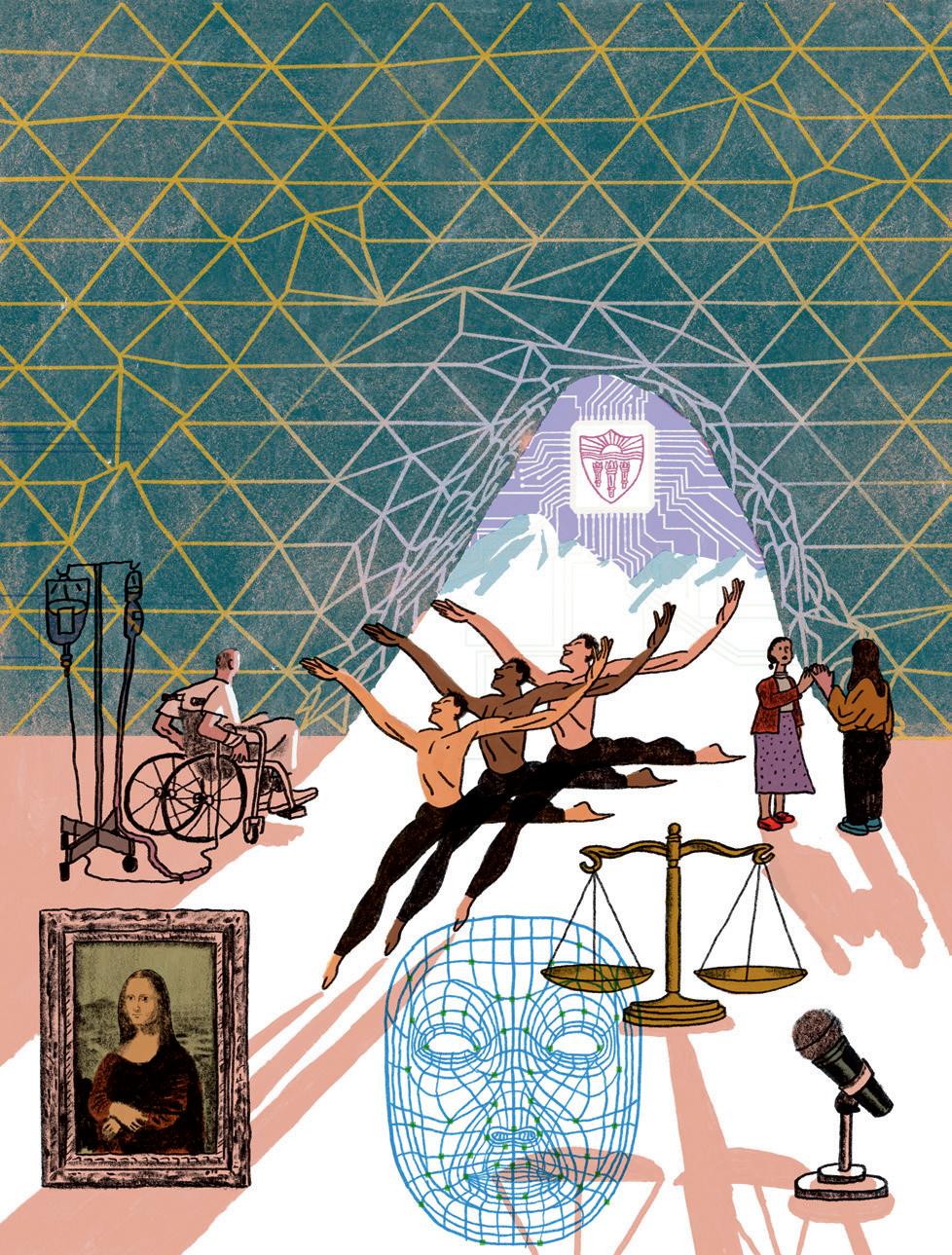
to launch the NSF I-Corps Hub: West Region, one of only five nationally. The recently inaugurated hub — in partnership with UCLA, the University of Colorado and five affiliate institutions, including the California Institute of Technology will accelerate tech commercialization, moving breakthrough discoveries from the lab to the marketplace.
In the process, USC and its collaborators in Silicon Beach will stimulate a culture of invention to spark job creation, economic growth and the development of deep-tech products and services that will improve people’s lives, Folt says.
USC has an enviable record of business creation. Second Spectrum, co-founded by two former USC professors, is the dominant sports analytics company for the National Basketball Association and soccer’s English Premier League Relativity Space, which designs and builds rockets such as Terran 1 — the world’s first entirely 3D printed rocket — was co-founded by USC Viterbi alumni Jordan Noone and Tim Ellis; some finance experts have valued it at more than $4.2 billion. Moving Analytics, which has developed the nation’s top virtual cardiac rehabilitation program, was co-founded by USC alumnus and postdoctoral researcher Harsh Vathsangam and his PhD adviser, Gaurav Sukhatme, the Fletcher Jones Foundation Endowed Chair in Computer Science and executive vice dean of engineering.
“The business opportunities and societal impact of the ever-more-rapid computing revolution are immense, and USC is at the forefront of both,” says Geoff Garrett, dean of USC Marshall School of Business. “With an entire academic department dedicated to data science, and with technically skilled faculty placed throughout all our business programs, we are well-placed not only to focus on the cutting-edge business applications of technologies like AI and blockchain, but also to understand and shape their consequences for society.”
Bill Dally, the chief science officer at Nvidia, a key innovator of computer graphics and AI technology, says he believes the USC Frontiers of Computing will have far-reaching benefits. “If you have a really strong university, industry springs up around it, as the alumni and professors start little companies to take research results and commercialize them,” he says. “An effort of this magnitude in Southern California can’t help but spur a computing industry resurgence in the
greater Los Angeles area. And [Frontiers of Computing] is going to be part of keeping us ahead of many of our international competitors in computing.”
Developing the Next Generation of Tech Talent

Alongside the changes in physical infrastructure and talent, advanced computing concepts will be embedded in the undergraduate curriculum across the university, strengthening interdisciplinarity and the dual degree options in data science and AI for non-engineering students. An early example of this synthesis is a new bachelor’s degree in business analytics jointly offered by USC Viterbi and the USC Marshall School of Business.
The increased availability and enhanced quality of computing classes, programs and degrees will touch the lives of all USC students, from art majors to computer scientists, USC Viterbi Dean Yannis C. Yortsos says.
This reimagining of technical education and digital talent development also underscores the university’s commitment to diversity and inclusion. This fall, about 30% of USC’s incoming undergraduate class came from historically underrepresented groups. Half of USC Viterbi’s and USC Marshall’s incoming undergraduates are women. To further address equity and inclusion, Frontiers envisions new tech partnerships to increase internships and scholarships for students from groups underrepresented in tech.
“We are developing talent pipelines to ensure USC develops tech workers who reflect the diversity we see here in L.A.,” Yortsos says. “This model is an approach we hope to see adopted elsewhere in higher education and the tech industry.”
Added Marian Croak, ’82, Google’s vice president of engineering and head of the tech giant’s responsible AI team: “Frontiers of Computing will not only lead to breakthrough advances in science and technology but will also expand this critical field to attract more underrepresented talent.”
The USC Frontiers of Computing comes at a pivotal moment: The fast-changing pace of technology requires more and better-educated workers. A report by the consulting firm Korn Ferry finds that by 2030, more than 85 million jobs worldwide could go unfilled due to a lack of skilled labor. The United States alone stands to lose an estimated $162 billion in tech sales if the predicted shortage of 6 million high-tech and other workers comes to pass.
As the No. 1 U.S. research university in overall computer science degrees conferred, USC expects to graduate more than 28,000 USC students with computing-related proficiency across different disciplines and degrees in the next decade. Industry leaders know that the USC Frontiers of Computing initiative will further position USC as the leading source of tech talent on the West Coast.
“Having USC pursue a program like this is going to create a lot of talent,” Nvidia's Dally says. “And hopefully we can hire a bunch of them.”
usc trojan family 25
RENDERED IMAGE COURTESY OF HOK
Opening in 2024, the 116,000-square-foot Dr. Allen and Charlotte Ginsburg Human-Centered Computation Hall will be the future home of USC computer science.
SCilicon Beach A Path to the Future at USC
A visual guide to where USC has made its mark in computing.
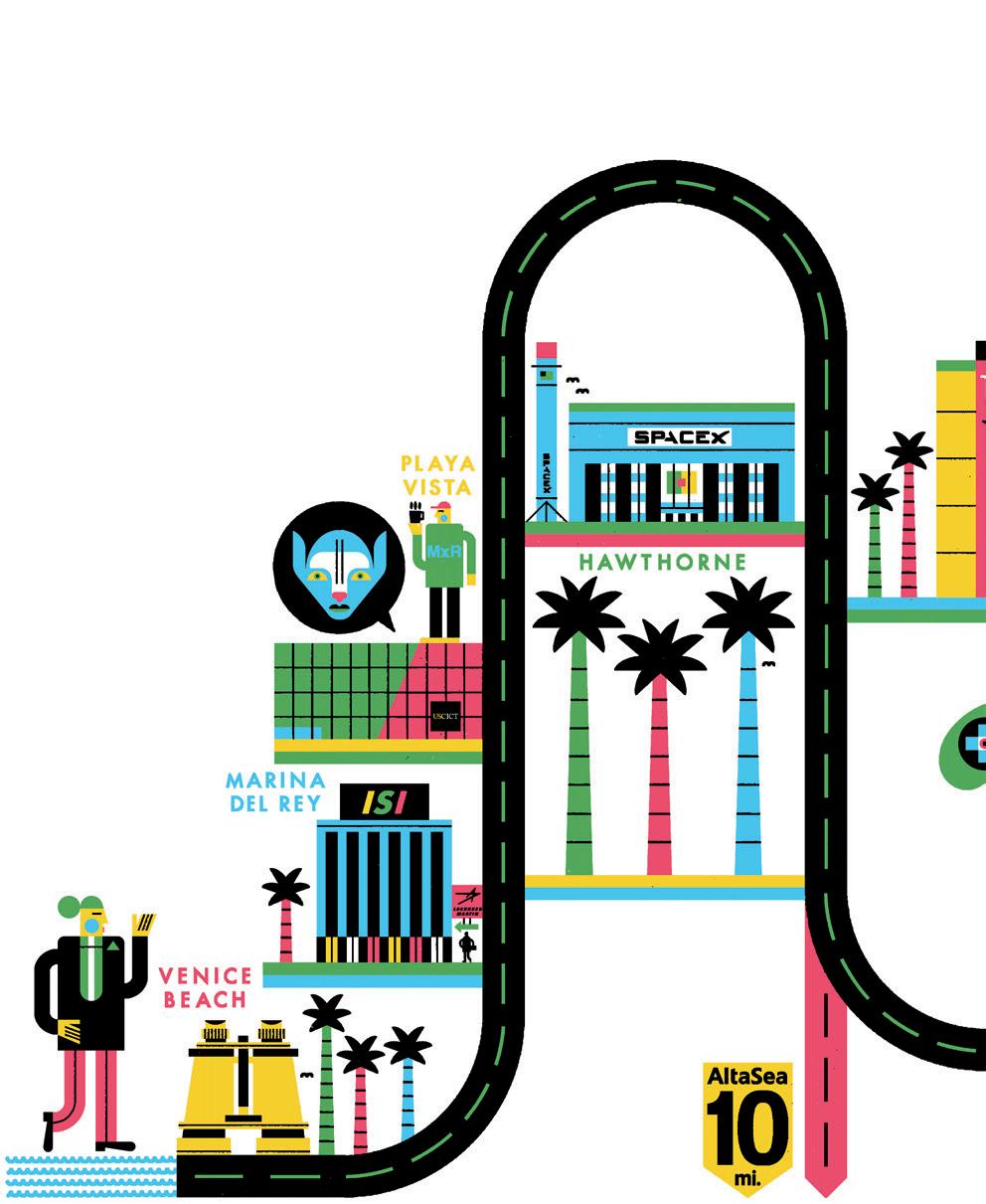 BY ADAM SMITH • ILLUSTRATION BY RAYMOND BIESINGER
BY ADAM SMITH • ILLUSTRATION BY RAYMOND BIESINGER
THE USC INSTITUTE FOR CREATIVE TECHNOLOGIES is a global leader in virtual humans, graphics, AI and mixed reality. The space houses the Vision & Graphics Lab, where USC’s Paul Debevec won an Oscar for creating characters for films such as Avatar, The Matrix and Gravity. It is also home to the Mixed Reality Lab (MxR), where former ICT engineer Palmer Luckey developed early versions of the Oculus Rift.
THE USC INFORMATION SCIENCES INSTITUTE (ISI) is USC’s “crown jewel” research institute that helped design, develop and run the early internet. ISI houses the USC-Lockheed Martin Quantum Computing Center, the only commercial quantum computing system in the world hosted and operated by a university. It is also home to DeterLab, the nation’s largest and most advanced test bed for R&D on next-generation cybersecurity. There are ISI centers located in Waltham, Mass., and Arlington, Va.
SPACEX, the world’s most recognizable private space company, employs more engineers from USC than any other school.
USC’S ALTASEA URBAN MARINE RESEARCH CENTER is a 35-acre lab that uses computing to create solutions in business and education that address climate change and global food security for the future of our oceans.
THE NSF I-CORPS HUB: WEST REGION is led by the USC Viterbi School of Engineering; the $15 million hub supports tech startups for the Western United States in partnership with seven universities.
THE USC SIGNAL
INSTITUTE is where coding research began for the JPEG and MPEG standards used for digital image compression — enabling today’s selfies.
THE USC CENTER FOR BODY COMPUTING was founded in 2006 as one of the nation’s first academically based digital health research and innovation centers.
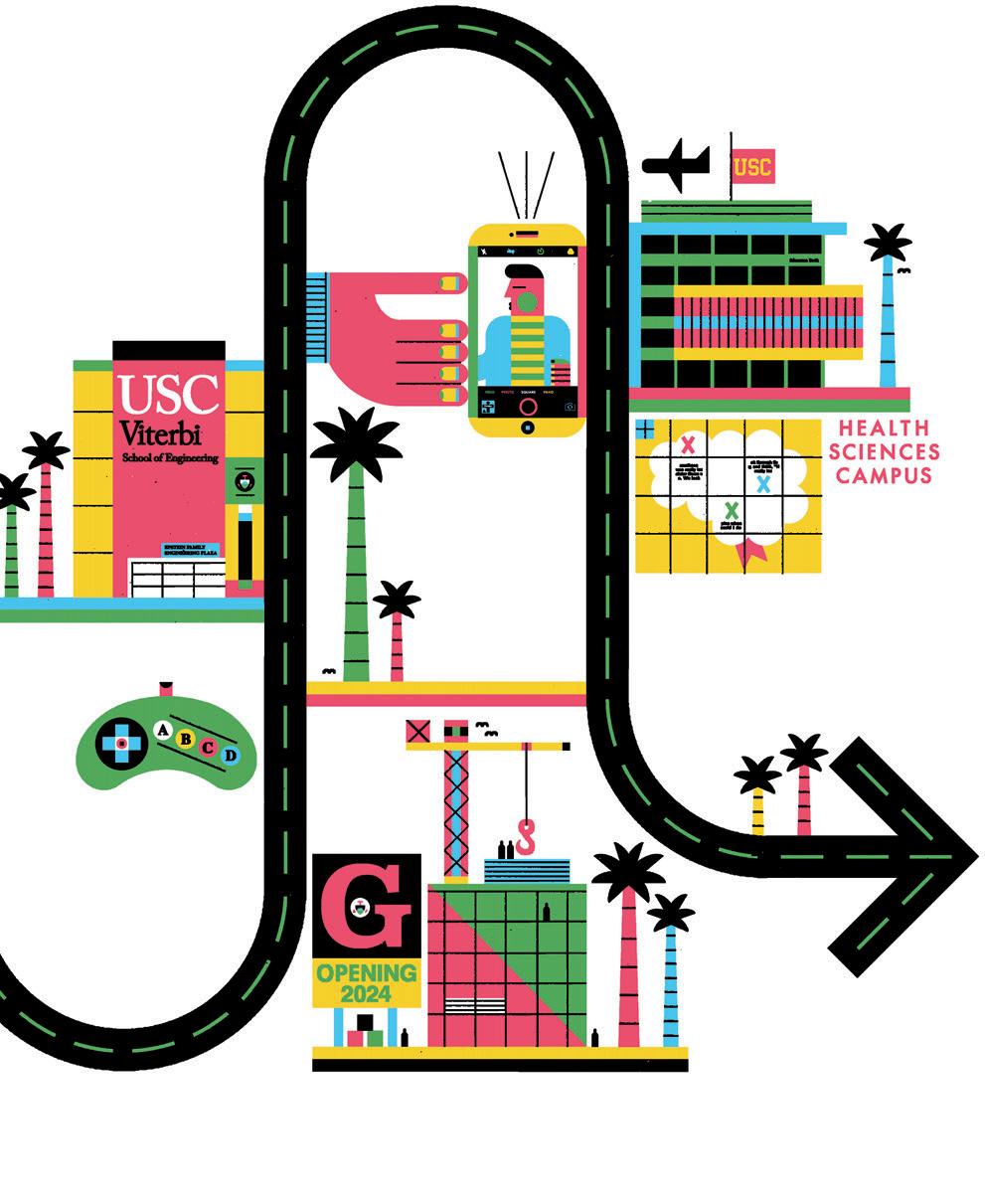
THE USC MARK AND MARY STEVENS NEUROIMAGING AND INFORMATICS INSTITUTE leads a massive, $17.8 million new AI study of Alzheimer’s disease, aiding precision diagnostics, prognosis and the development of new treatments.
USC GAMES, ranked the top games program in the country for more than a decade, is a joint program between the USC School of Cinematic Arts and USC Viterbi.
27
DR. ALLEN AND CHARLOTTE GINSBURG HUMANCENTERED COMPUTATION HALL opens in 2024; the 116,000-square-foot facility will be home to the new USC School of Advanced Computing.
AND IMAGE PROCESSING
UNIVERSITY PARK CAMPUS
Big
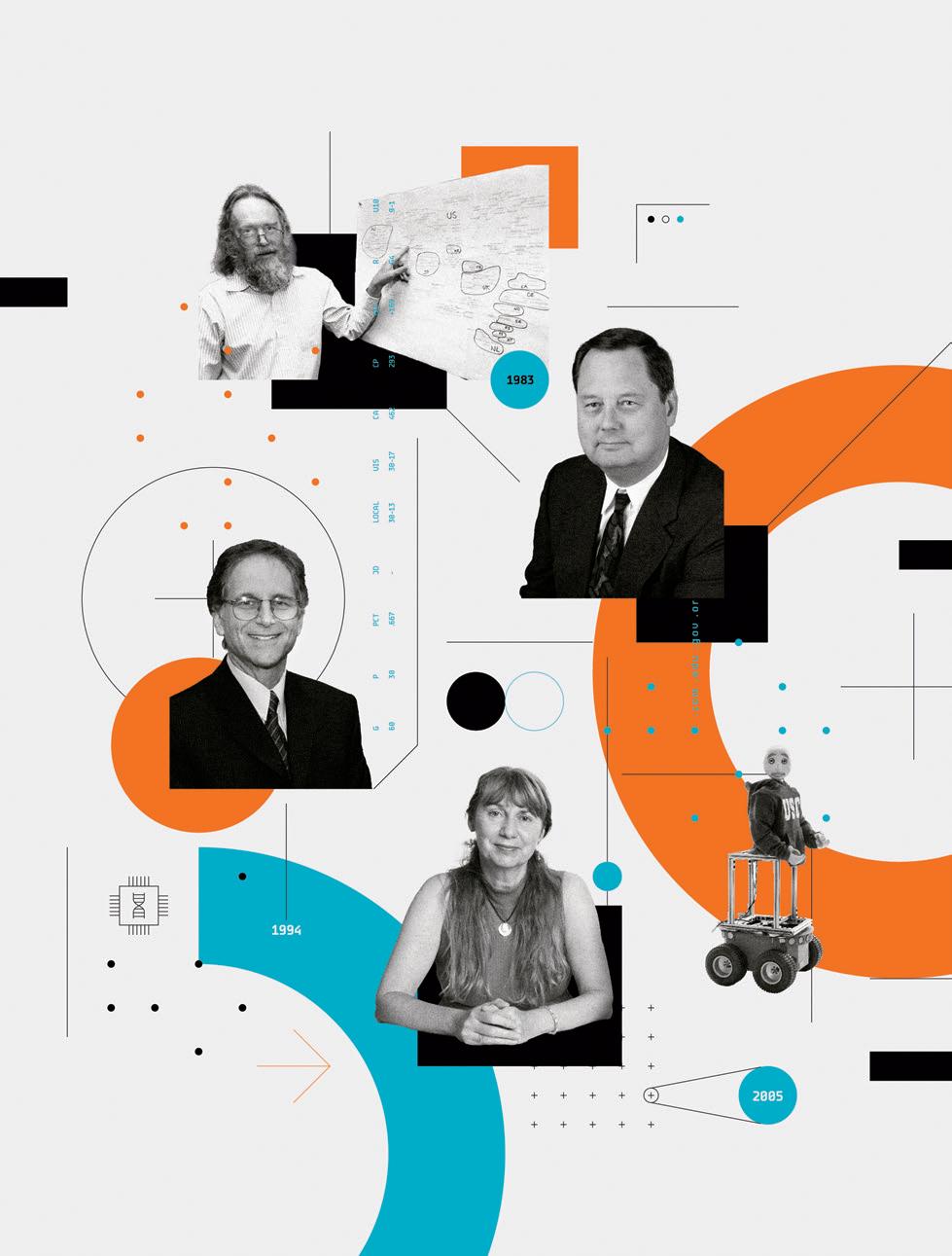
Clockwise from top left : ISI 's
Jon Postel and Paul Mockapetris; Roboticist
Maja Matari ć and the Bandit robot ; Len Adleman, pioneer of DNA computing.
USC’s
Wins in Advanced Computing
From quantum computing to robotics to machine learning, seven breakthroughs established USC on the actual frontiers of computing.
BY ADAM SMITH • ILLUSTRATIONS BY ISRAEL VARGAS
USC has been an animating force driving computing research forward since the late 1960s.
With the advent of the USC Information Sciences Institute (ISI) in 1972 and the Department of Computer Science in 1976 (born out of the Ming Hsieh Department of Electrical and Computer Engineering), USC has played a propulsive role in tech, from the internet to the Oculus Rift to recent Nobel Prizes.
1983 The .com
While working at ISI, Paul Mockapetris and Jon Postel pioneered the Domain Name System (DNS), which introduced the .com, .edu, .gov and .org internet naming standards in 1983.
The DNS works like a phone book for the internet, automatically translating text names, which are easy for humans to understand and remember, to numerical addresses that computers need. For example, imagine trying to remember an IP address like “192.0.2.118” instead of simply “usc.edu.”
In a 2009 NPR interview, Mockapetris said the first domain
name he ever created was “isi.edu” for his employer, the USC Information Sciences Institute — and it is still in use today.
As Wired Magazine noted on the 25th anniversary of DNS, “Without the [DNS], it’s doubtful the internet could have grown and flourished as it has.”
1994 DNA Computing
In 1994, Professor Leonard Adleman, who coined the term “computer virus,” invented DNA computing, which involves performing computations using biological molecules rather than traditional silicon chips.
Adleman — who received the 2002 Turing Award, often called the Nobel Prize of computer science — saw that a computer could be something other than a machine using electrical impulses. After visiting a USC biology lab in 1993, he recognized that the 0s and 1s of conventional computers could be replaced with the four DNA bases: A, C, G and T. As he later wrote, a “liquid computer” can exist in which interacting molecules perform computations.
29 usc trojan family Big
“We’ve shown by these computations that biological molecules can be used for distinctly non-biological purposes,” Adleman said in 2002. “They are miraculous little machines. They store energy and information; they cut, paste and copy.”
2005
Socially Assistive Robotics
Socially assistive robotics is a new field that focuses on providing social support so people can overcome challenges in health, wellness, education and training. Pioneered in the USC Interaction Lab led by Maja Matarić, socially assistive robots have been developed for a broad range of user communities, including infants with movement delays, children with autism, stroke patients, people with dementia and Alzheimer’s disease, and otherwise healthy elderly people.
“We want these robots to make the user happier, more capable and better able to help themselves,” said Matarić, the Chan Soon-Shiong Chair and Distinguished Professor of Computer Science, Neuroscience and Pediatrics at USC. “We also want them to help teachers and therapists, not remove their purpose.”
The field has inspired investments from federal funding agencies and technology startups. The assistive robotics market is estimated to reach $25.16 billion by 2028.
2011
Academia’s Only Quantum Computing System
Defined as “the ultimate disruptive technology,” quantum computing can crunch massive data and variables quickly, giving it the potential to do everything from optimizing batteries for electric cars, predicting weather and models for climate change, or creating the best possible investment portfolio.
Today, USC is the only university in the world to host and operate a commercial quantum computing system. Launched in 2011, the D-Wave One — the first commercial quantum processor — is located at the USC-Lockheed Martin Quantum Computing Center (QCC), led by USC Viterbi Professor of Engineering Daniel Lidar and ISI’s Robert F. Lucas.
Recently, QCC upgraded to D-Wave’s Advantage system, with more than 5,000 qubits, or quantum bits, the basic units of information in a quantum computer. Larger than any other quantum computer, the upgrades will allow businesses, researchers and government agencies remote access through the Leap quantum cloud system.
2015
Speaking to the Past in the Future
New Dimensions in Testimony, a collaboration between USC Shoah Foundation and the USC Institute for Creative Technologies (ICT), in partnership with tech company Conscience Display, is an initiative to record and display testimony in a way that will continue the dialogue between Holocaust survivors and learners far into the future.
The project uses ICT’s Light Stage technology to record interviews using multiple high-end cameras for high-fidelity playback. The ICT Dialogue Group’s natural language technology allows fluent, open-ended conversation with
the recordings. The result is a compelling and emotional interactive experience that enables viewers to ask questions and hear responses in real-time, lifelike conversation — even after the survivors have passed away.
New Dimensions in Testimony debuted in the Illinois Holocaust Museum & Education Center in 2015. Since then, more than 50 survivors and other witnesses have been recorded and presented in dozens of museums around the United States and the world. It remains a powerful application of artificial intelligence (AI) and graphics to preserve the stories and lived experiences of culturally and historically significant figures.
2016 AI for Good
Launched in 2016, the Center for AI in Society (CAIS) became one of the pioneering “AI for Good” centers in the United States, uniting USC Viterbi and the USC Suzanne Dworak-Peck School of Social Work.
In the past, CAIS used AI to prevent the spread of HIV/AIDS among homeless youth. In fact, a pilot study demonstrated a 40% increase in homeless youth seeking HIV/AIDS testing due to an AI-assisted intervention. In 2019, the technology was also used as part of the largest global deployment of predictive AI to thwart poachers and protect endangered animals.
Today, CAIS fuses AI, social work and engineering in unique ways, such as working with the Los Angeles Homeless Services Authority to address homelessness; battling opioid addiction; mitigating disasters like heat waves, earthquakes and floods; and aiding the mental health of veterans.
2017 Fighting Modern Slavery
In 2017, a team of researchers at ISI led by Pedro Szekely, Mayank Kejriwal and Craig Knoblock created software called DIG that helps investigators scour the internet to identify possible sex traffickers and begin the process of capturing, charging and convicting them.
Law enforcement agencies across the country, including in New York City, have used DIG as well as other software programs spawned by Memex, a Defense Advanced Research Projects Agency (DARPA)-funded program aimed at developing internet search tools to help investigators thwart sex trafficking, among other illegal activities. The specialized software has triggered more than 300 investigations and helped secure 18 felony sex-trafficking convictions, according to Wade Shen, program manager in DARPA’s Information Innovation Office and Memex program leader. It has also helped free several victims.
In 2015, Manhattan District Attorney Cyrus R. Vance Jr. announced that DIG was being used in every human trafficking case brought by the DA’s office. “With technology like Memex,” he said, “we are better able to serve trafficking victims and build strong cases against their traffickers.”
“This is the most rewarding project I’ve ever worked on,” said Szekely. “It’s really made a difference.”
30 usc trojan family
Clockwise from top left: Bistra Dilkina and Eric Rice, CAIS codirectors; Craig Knoblock, Pedro Szekely and Mayank
Kejriwal of ISI; Pinchas Gutter, a Holocaust survivor at the ICT Light Stage; Daniel Lidar, USC quantum computing leader.
 BY ADAM SMITH • ILLUSTRATIONS BY YUTA ONODA
BY ADAM SMITH • ILLUSTRATIONS BY YUTA ONODA

The Places That Built Me
Professor Burçin Becerik-Gerber imagines living with “smart” buildings.
Engineering
Imagine a boring, static office space where I sit, on deadline, with my latest proposal. Now, what if the building knows this? And the building changes accordingly?


First, let there be light. And colors soft whites, blues and greens.
Then, lots of energy and motion, like a Starbucks at 8 a.m. The building knows I’m always cold. It adjusts to 75 degrees. The smell that briny, jasmine and honeysuckle smell of the Aegean Sea. The music … something by Queen. “Under Pressure.” Perfect.
According to the EPA, Americans spend 87% of their lives inside buildings, 6% of their lives in cars and only 7% of life outdoors.
Given that, what if buildings could be something more than glass, concrete and steel boxes that keep out the rain?
usc trojan family 33
What if they were more like a friend?
The first space that really mattered to me, actually, was not a built one.
I grew up in a pretty windy place. Izmir, on the Turkish coast. The meltemi, the strong breezes, felt like freedom.

To this day, I don’t believe in curtains, or anything that would blot out nature, deny the sun, the wind, the smell of the sea.
When I was a college student in Istanbul, I marveled at the Hagia Sophia. Here was a sacred building that was once a church, then a mosque, then a museum and now a mosque once more.
Gazing at the icons of Islam and Christianity on the walls, I couldn’t help but feel the sense of mismatch. It’s a feeling I’ve known my entire life : an architect with the mind of an engineer.
But the buildings that have shaped me the most were the ones that lost their shape. More than 20 years before the February earthquake struck Turkey and Syria, the Izmit earthquake of 1999 left shattered, pancaked buildings.
But more than that, it left 17,000 people dead. Close friends from high school. Nearly 45,000 injured. And it was all so unnecessary. Poor construction. Soil studies ignored (or never done).
That was the day I decided to become an engineer. What good were pretty buildings if they couldn’t keep you safe?

usc trojan family 35
At age 23, I journeyed to a new world.
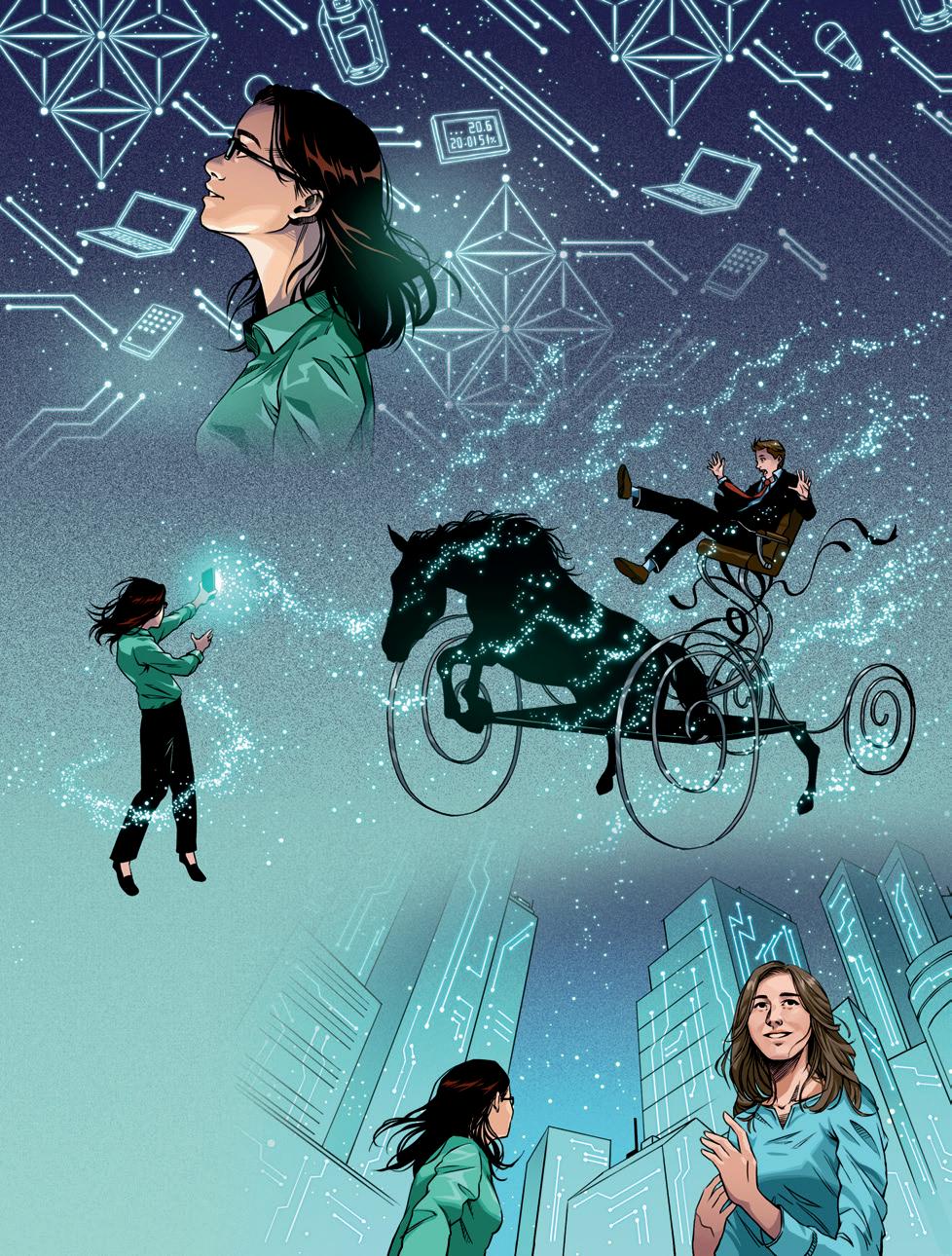
That was true in a literal sense. I’d never left Turkey before. But going to graduate school in Silicon Valley, it was like discovering a new planet.
The biggest challenge in research is not related to technology in general. It’s an imagination deficit.
People have a hard time imagining a static object like a wall or a desk or a chair having a meaningful interaction with a human being.
But I’ve been imagining things coming to life since I was a kid, hearing stories of Cinderella’s pumpkin carriage.
In the Center for Intelligent Environments (CENTIENTS) at USC, we have no such deficit.
We bring together engineers, computer scientists, psychologists, architects, and business and security experts to imagine new smart buildings that adapt to the needs of human beings.
Imagine a building that fights to keep you healthy during a pandemic. For example, cold weather does slow down our immune system.
But a major reason we get colds and flu more often in the winter is because we are inside more often and exposed to higher concentrations of airborne pollutants, including cold and flu viruses.
What if we could fight respiratory diseases, migraines, back pain, dry eyes and fatigue with AI-powered ventilation, humidity, light and color, glare control and even smart workstations?

Imagine a building that could help prevent the next Sandy Hook or Columbine.
What if the building could detect and isolate the would-be shooter? What if it could automate 911 calls and provide “safe path” information to terrified, information-starved occupants?
We recently finished active-shooter VR simulations with 170 office workers and teachers. The goal: to create an intelligent building that can intuitively adapt to the unimaginable.
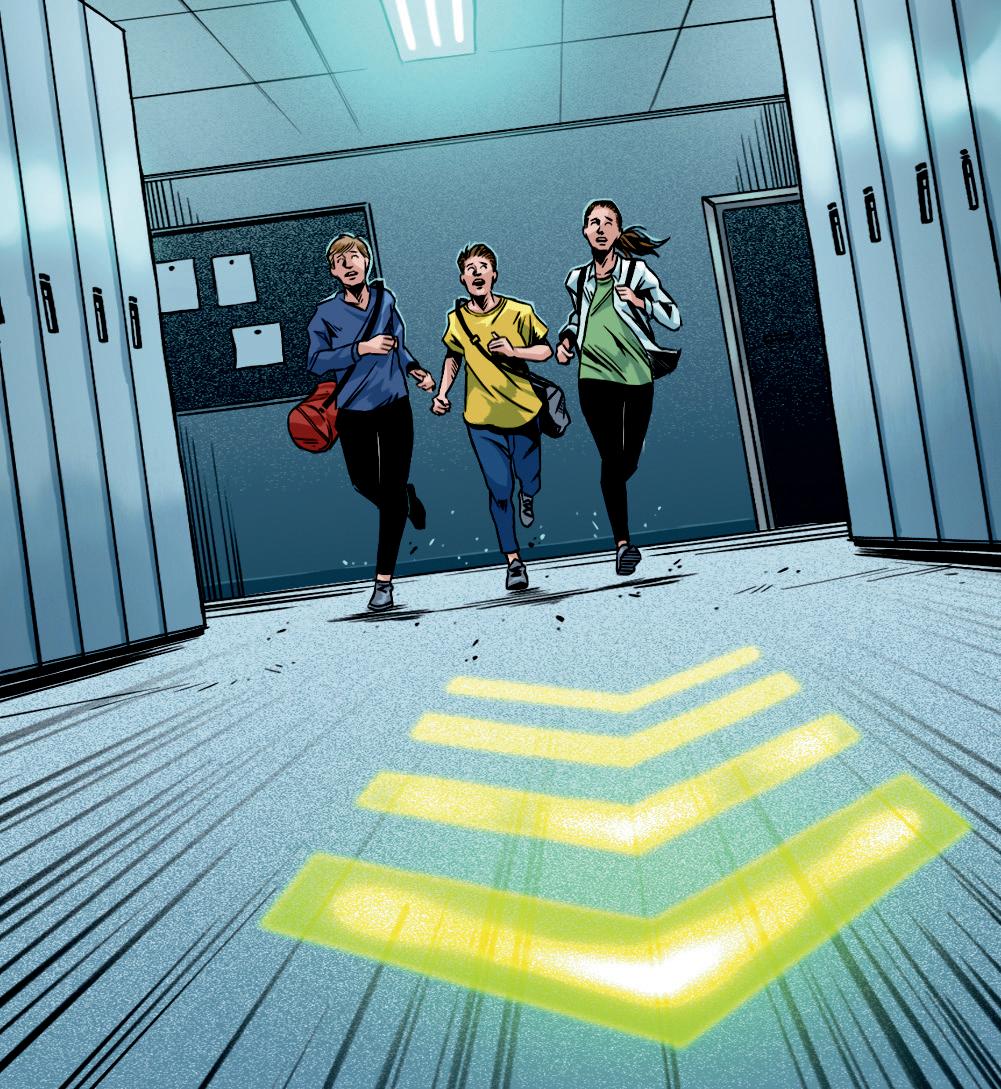
usc trojan family 37
Imagine a building that is a better steward of our planet.
We know that buildings consume 40% of U.S. energy, and most buildings are designed for 100% occupancy. What if a building was intelligent enough to know who really uses its spaces, and when?


We believe we could reduce energy use by more than 30% by using sensing and virtual agents to balance individual comfort with overall sustainability.
Finally, imagine a building that allows more productivity and inclusivity.
In 2017, we partnered with Arup to design a smart desk that uses machine learning to adjust temperature, color of lights, ergonomics, olfactory smells, even music or white noise levels, based on user preferences and sensing things such as skin blood flow through infrared thermography.
Someone with autism, for example, might experience hypo- or hypersensitivity to everyday sensory information. What if the building knew that?
38 usc trojan family
Autumn 2023
Some people might prefer their building avatar as a voice (typically feminine), a video character, a text alert or even haptic feedback.
“Hi, Burçin, you’ve been working hard for the last five hours. What do you think about taking your 2p.m. call outside?”
For me, I might prefer the building’s avatar as another object: a fluffy, cute robot.
What if, in a strange twist of fate, becoming closer to our buildings actually encouraged us to leave them more?

You know the drill: You’re scrolling through Amazon or any other shopping website, and an item sparks your interest. Even though you didn’t “add to cart” or put it in a “favorites” list, you spent a lot of time looking at that page. So, when you move on to another website, an advertisement for that same item pops up.
This is a relatively mundane example of artificial intelligence (AI) at work, with an algorithm targeting your preferences based on your online behavior. But AI has the power to veer in more troubling directions — possibly blocking you from seeing specific job opportunities or home loan programs based on your socioeconomic background or race.
While controversial, AI systems have become an inextricable part of our daily lives. They can help people orga-
creative work, making some educators concerned that students will use the bot and pass the AI work off as their own.
But for faculty members like Mike Ananny, an associate professor at the USC Annenberg School for Communication and Journalism, ChatGPT can be a tool just like anything else. He argues that framing it as a tool for cheating might say more about people than the actual AI.
“It feeds this culture of treating students like they’re about to cheat,” Ananny says. “That approach to student-teacher relations misses the mark.”
Ananny thinks the issue is more how it is used than what it is capable of. The generator might be able to create longer pieces, but it’s still up to the students to edit and ensure what was generated is accurate.
“The act of editing and revising something ChatGPT produces can be a really valuable learning experience because you have to know a lot more [about the subject] to edit something,” Ananny says.
Kimon Drakopoulos, an associate professor at the USC Marshall School
Ifs, Ands, and Bots
Does artificial
intelligence sabotage equity ? BY
nize their schedules, aid wildlife conservation or spot “fake news.” But these systems can also replicate and reinforce prejudices, or aid in academic or artistic fraud.
Whether it makes our lives easier or more difficult is often up to us, USC experts say.
“We’re our own foes, and AI just kind of propagates that,” says Fred Morstatter, research assistant professor of computer science at the USC Viterbi School of Engineering. “It all comes down to that adage of ‘garbage in, garbage out.’”
Reinforced Bias
Algorithms — a set of instructions that can be as simple as an “if-then” equation — aren’t inherently problematic. AI is an overlapping term that refers to a group of algorithms that can modify itself and create new algorithms based on learned inputs and data.
“There are algorithms now that predict whether or not you should get a loan, and they’re trained on past data — people who got loans and who didn’t,” says Morstatter, who specializes in AI bias. “There’s racial bias in those data sets, so they propagate that data going forward. People have a cloudy understanding that [AI] can be biased, but the fact that it’s baked into the things you interact with daily is missing.”
Useful Tool or Enabler?
A significant concern about AI, especially in academia, is how it can develop content with minimal input — e.g., a quick prompt — leading to issues of plagiarism and academic dishonesty.
Using the popular OpenAI chatbot ChatGPT, for example, users can provide a prompt such as “Explain tornadoes” and receive an AI-generated response.
ChatGPT can also write full pieces of academic or
GRAYSON SCHMIDT
of Business who specializes in AI, says the outrage around technological advances in academia is familiar.
“It’s the same situation as in the ’90s when people were demonizing the internet and how encyclopedias weren’t going to be relevant anymore,” Drakopoulos says. “I see it as an opportunity and not at all a threat.”
Lost in an OnlineWorld
Stephen Byars, a professor of clinical business communication at USC Marshall, says that people, as consumers, need to be honest with themselves about AI.
“In every application and design of AI, we have to decide whether it is making our lives better,” Byars says. “Is it giving us useful technology for the work we want to do and for the human relationships we want to have? Or does it isolate us more and put us in environments where our only contact is with our laptop or phone?”
In a way, Byars notes, the COVID-19 pandemic allowed the public to let its guard down in terms of privacy. When the world went virtual, how could we not divulge more about ourselves just to stay connected?
“To the extent that AI can free us up to have more time [for ourselves] or have richer contact with each other, those are good things,” Byars says. “But AI also can make us prisoners of a technical environment — it’s just so easy to get lost in an online world.”
Byars acknowledges the pitfalls of being online. But when he brings up the prospect of less privacy to his students — for example, all phones have cameras and location services — the majority don’t see an issue. Many of them “just accept this as a normal accompaniment to the greater use of technology,” Byars says.
Morstatter recommends taking control of managing private information online by tricking algorithms: tagging yourself as multiple people on Facebook or Instagram so the algorithm can’t recognize your face, or simply choosing not to allow cookies.
Morstatter says AI ethics come down to education: knowing what data is collected and how to limit what you allow. Ultimately, AI is intended to make our lives easier, which gives users the power to determine how it’s used.
“I seldom blame the algorithm,” Morstatter says. “I just don’t think there are too many algorithm designers out there trying to destroy the world.”
40 usc trojan family
ILLUSTRATION BY JOSH COCHRAN

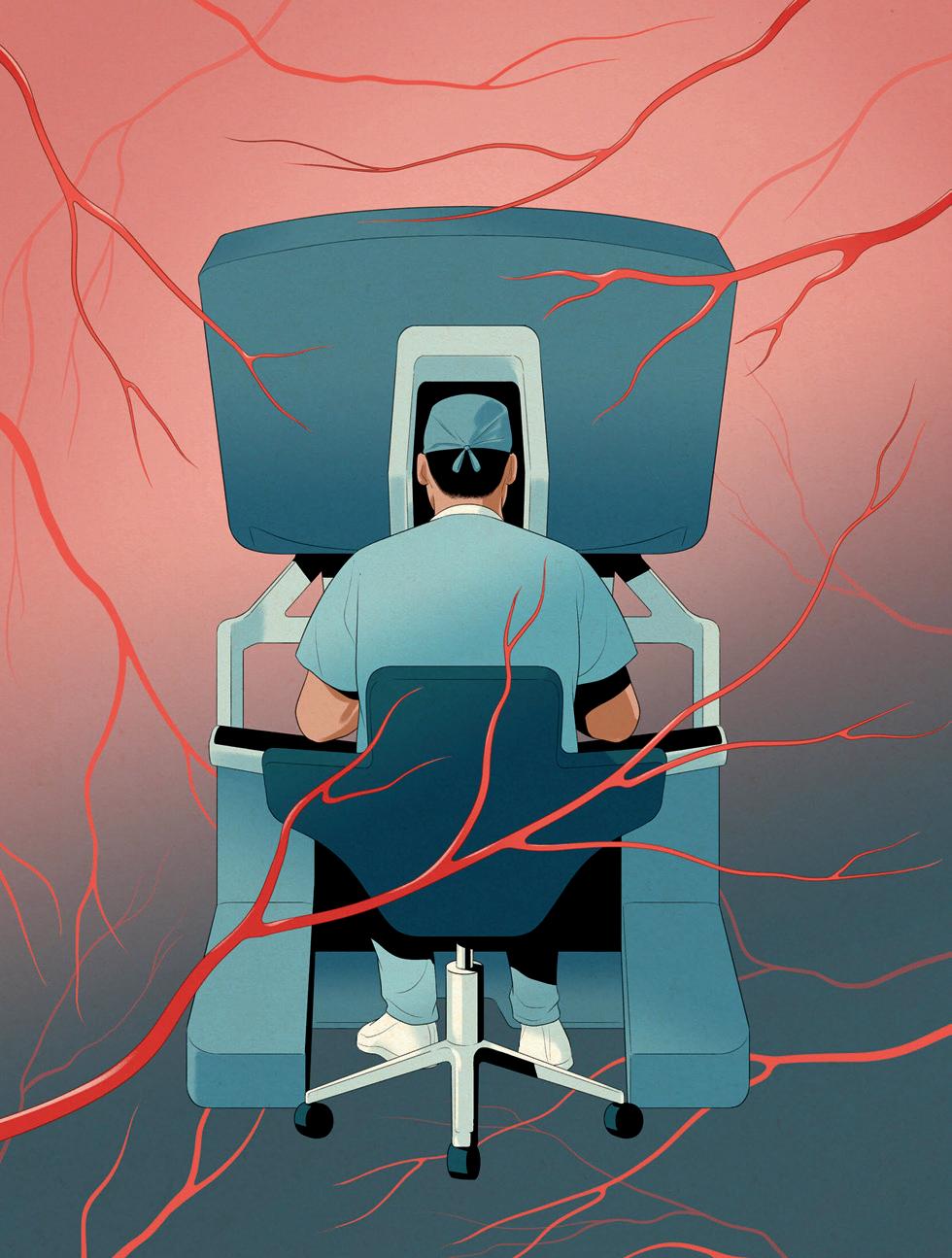
In the operating room at Keck Hospital of USC, urologist Inderbir “Indy” Gill is “on the robot.”
That’s his way of saying he’s performing surgery with the aid of a robotic system called da Vinci Xi.
Gill — who is chair and distinguished professor of the Catherine and Joseph Aresty Department of Urology of the Keck School of Medicine of USC, founding executive director of Keck Medicine’s USC Urology, and the Shirley and Donald Skinner Chair of Urologic Oncologic Surgery — sits at the console manipulating instruments that control the system’s four robotic arms. Each arm is outfitted with surgical tools about the size of a pencil tip that can cut and connect human tissue with greater precision than possible with larger tools held by human hands.
expanded to include transplantation of body parts such as the face, hand, penis and uterus.
So, why hasn’t a bladder been transplanted before?
Part of the answer is that other surgical solutions for replacing a diseased bladder already exist.
Bladder removal (cystectomy) is a common treatment for invasive bladder cancer, as well as for some neurological conditions and inflammatory diseases that impair the bladder’s ability to store and empty urine. After cystectomy, the surgeon creates a new way for urine to exit the body (aka “urinary diversion”).
For decades, the gold standard for urinary diversion has been to refashion a part of the patient’s own intestine. Some patients receive what’s known as an ileal conduit, in which a piece of intestine is used to
TransplanTrailblazer
BY RACHEL B. LEVIN • ILLUSTRATIONS BY ANUJ SHRESTHA
Gill’s field of vision is completely immersed in the console’s stereoscopic monitor. A high-definition, 3D camera beams magnified images of the patient’s abdominal tissues onto the screen.
“I’m completely inside the patient’s belly, virtually speaking,” Gill says. “I don’t see anything else around me.”
Integrating emerging technologies into his vision for advanced urological cancer procedures has made Gill a surgical pioneer. He’s one of the first and most highly regarded robotic surgeons in the field of urology, and the team he leads at USC has emerged as a world leader in robotic, minimally invasive techniques for treating kidney, bladder, prostate and testis cancer.
Now, Gill is pushing the boundaries of robotic surgery even further as his team looks to perform the world’s first human bladder transplant in an investigational research trial.
In April, after over two years of preclinical research to develop transplant techniques, Gill launched a clinical trial that will soon enroll its initial bladder transplant recipient. The research has the potential to revolutionize the way urologists treat a select subset of patients with debilitating bladder conditions and significantly enhance their quality of life.
“We’re always trying to figure out new ways to improve the current standard of care,” Gill says of his research team. “Our desire to serve our patients propels us to innovate treatments that have never been done before — and the lack of precedent does not stop us.”
CHALLENGING THE STATUS QUO
Since 1954, when the first human organ (a kidney) was successfully transplanted, transplant surgery has been primarily limited to organs critical to keeping a person alive, such as the heart, lungs, liver and kidneys.
But Gill notes that in the past 10 to 15 years, the field has
form a tube that protrudes through the side of the abdomen and directs urine to a bag worn outside the body. Others receive a “neobladder,” a bladderlike pouch made of intestinal tissue that is attached to the urethra and allows patients to urinate through the normal channel.
But Gill points to a range of complications that can ensue when surgeons connect bowel tissue, which contains bacteria, to the urinary tract, which is sterile: recurrent infections, stone disease, gradual reduction of kidney function, and electrolyte imbalances, among others. When patients lose a portion of their intestines, they may also have problems absorbing food. Forty to eighty percent of patients with intestine-built urinary diversion experience varying degrees of short- and long-term complications.
“We have accepted the morbidity and the complication rates that are associated with the use of the bowel in the urinary tract,” Gill says. “No one has thought, ‘Hey, can we do better? Are there some patients who might benefit from a bladder transplant?’ — which to us is rather stunning, that it has not been explored.”
UNTIL NOW…
Gill reasoned that although a bladder transplant would bring its own risks, it could sidestep the complications of using intestinal tissue and offer select patients a more normal bladder substitute.
As Gill and his team began to brainstorm about how to execute a bladder transplant, they had to contend with the second reason no one had previously attempted it: the surgical complexity.
Typically, when a diseased bladder is removed, the blood vessels around the patient’s bladder do not have to be preserved because the organ will no longer be used. But if Gill were to remove a healthy bladder from a deceased donor, those blood vessels would need to be preserved so they could function for the transplant recipient.
“That is orders of magnitude more technically challenging,”
usc trojan family 43 trojan health
A
renowned urologic surgeon at Keck Medicine of USC is on the verge of performing the world’s first human bladder transplant clinical trial. His skills in robotic surgery — and zeal for innovation — are making it possible.
Gill says. “You have to go into the deep pelvis.”
Steven Shapiro, who oversees Keck Medicine of USC and the Keck School of Medicine as senior vice president for health affairs, notes that Gill came to this challenge with the skills and mindset needed to tackle it. “He’s fearless,” Shapiro says. “The bladder is a very highly vascularized [blood vessel-rich] organ. Quite frankly, it would scare most surgeons away.”
ROBOTS TO THE RESCUE
About two years ago, Gill teamed up with his then-resident Nima Nassiri — who is now a faculty member in transplant surgery at the David Geffen School of Medicine at UCLA — to develop and test a first-of-its-kind surgical approach to bladder transplant. Their research, whose results will appear in the October 2023 issue of The Journal of Urology, involved performing bladder transplantation first on pigs, then on human cadavers, and finally on heart-beating, braindead human research donors.
As anticipated, taking the bladder and its intact vessels out of the donor proved to be the most challenging part of the procedures — and this is where Gill’s facility as a robotic surgeon was crucial for success.
The team performed both open surgery (with handheld surgical tools) and robotic surgery and found the robotic approach to be
but they regarded the research as an essential, big first step.
While Gill is pleased by this initial reaction, much work lies ahead. “The research to date has raised more questions than answers,” he says.
One unknown is how the transplanted bladder, which will be attached to the recipient’s urethra, will function, given that it would be devoid of nerve connections that control its contractions.
“While it should work nicely as a storage organ, it may not expel urine as well as the normal bladder,” says Gill. That could mean that transplant recipients may need to periodically empty their bladders by manual abdominal pressure or with a catheter. However, Gill plans to leave intact the net of nerves surrounding the donor bladder, so it’s possible that new nerve connections may regrow, either spontaneously or by nerve grafting. Another option is to implant a stimulator to deliver an electric current to excite the bladder to initiate bladder contractions.
Even if a transplanted bladder becomes a seamless replacement for the patient’s own bladder, Gill cautions that applications of the treatment will be limited initially. “At the end of the day, any transplant is done only for extreme scenarios,” Gill says. “No transplant is done where the organ is working, let’s say, 50%. It is done only when it’s down to near zero.”
Another limiting factor is that any patient who receives an organ transplant needs to take immunosuppressive drugs (which suppress the immune system) to decrease the chances of organ rejection. These drugs also interfere with the immune system’s role in fighting cancer, which means most patients with active cancers would not be good candidates for a bladder transplant — unless they were already taking immunosuppressive drugs for another health issue.
superior. It allowed a more magnified view of the pelvic organs and greater ability to control potentially dangerous bleeding from the deep pelvic blood vessels.
Even with the robotic assistance, there was a steep learning curve. Typically, when Gill removes a bladder robotically for cancer treatment, it takes him only about 45 minutes. “The first bladder we removed for the transplant from the heart-beating donor took 11 hours,” Gill says. Eventually, with repeated practice and refinement, they were able to whittle the time down to four hours.
The next step was to prepare the donor bladder for transplant into the recipient, and Nassiri and Gill innovated time-saving techniques here, as well. On the surgical back table, they connected the bladder’s right and left artery to each other and right and left veins to each other, creating one artery and one vein. That meant they only had to make two connections to the recipient’s blood vessels rather than four. Gill made those vascular connections robotically with high precision.
Over a two-year period, they worked nights and weekends, in addition to their ongoing clinical and surgical duties serving patients, to perfect their techniques until they were satisfied with the results. Ultimately, transplantation proved to be a success in multiple heart-beating, brain-dead donors, with good blood flow to the new bladder as evidenced by pink, healthy tissue.
A NEW SET OF QUESTIONS
When Nassiri and Gill shared the results of their preclinical research at the annual meeting of the American Urological Association in April 2023, the response from the urologic transplant community was uniformly positive. The first word out of the session moderator’s mouth was, “Wow!” Transplant surgeons in the audience came up to the microphone, and their first response was also, “Wow!” Their peers peppered Gill and Nassiri with questions,
Despite these limitations, Gill is optimistic that well-selected individuals could experience life-changing benefits from bladder transplantation. He points to patients with nervous system injury to the bladder and those with chronic inflammatory bladder disease as possible examples. These conditions can cause debilitating shrinkage of the bladder, diminishing its storage capacity.
“Such patients are going to the restroom 10 to 20 times during the day and also at night, and/or have severe pelvic pain,” Gill says. “And medications have failed. Basically, their life revolves around this, and it can drive one to desperation. Whether bladder transplantation in such folks would be viable remains to be seen. But at least from a conceptual perspective, it’s appealing.”
MAKING HISTORY
The next step in the process — to transplant a bladder into a living human patient for the first time — depends upon finding the right candidate and donor availability. Gill anticipates they should find a match within the next three to six months. He hopes to enroll 10 patients in this first clinical trial. Already, he has received inquiries from patients and their providers around the world who are interested in participating.
Shapiro isn’t surprised that Gill’s research has attracted attention from the national and international medical community. “It really is just an exemplar of what great clinical care we do [at Keck Medicine of USC] and how we do it in an academic way to bring new therapies to life,” he says.
It’s precisely that spirit of innovation that keeps Gill and his team motivated to push forward.
If there’s an opportunity to introduce a groundbreaking treatment to the world, “then you got us where we live,” Gill says. “Making possible what once seemed impossible is our beating heart.”
44 usc trojan family Autumn 2023
“No one has thought, ‘Hey, can we transplant the bladder?’ — which to me is rather stunning.” — INDERBIR GILL

LIMITLESS POSSIBILITIES
No matter what dreams you may have on the horizon, our expert health care team is here to partner with you to realize your potential. When you review your insurance options this Open Enrollment season, select a network that includes the awardwinning care of Keck Medicine of USC. Together we are limitless.

Keck Hospital of USC
USC Arcadia Hospital
USC Care Medical Group
USC Norris Cancer Hospital
USC Verdugo Hills Hospital
KeckMedicine.org © 2023 Keck Medicine of USC
Open Enrollment starts SOON!
FAMILY


usc trojan family trojanfamily.usc.edu 47
MOM STAYS IN THE PICTURE Family and friends document the beginning of USC’s 140th commencement ceremony held at the University Park Campus on May 12.
PHOTO BY GUS RUELAS
100 Years of the Trojan Family
Since 1923, the USC Alumni Association has brought Trojan graduates together to engage with each other and build community. Here’s a look at the most pivotal moments of USC’s alumni engagement history, as well as the first 100 years of the USC Alumni Association.
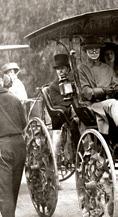
1992 USC Lambda (today’s Lambda LGBTQ+ Alumni Association) is founded. “While the atmosphere in the 1990s was one of tolerance, it wasn’t one of acceptance,” founder Don Gabard says. “USC is known for its ability to connect alumni with students, for networking and mentoring opportunities. But in our LGBTQ+ community, inclusion was not a foregone conclusion in that mentoring network.”
1996
Len Fuller ’68 becomes the first Black GAA president.
1998
Several years after discontinuing its membership dues programs, the GAA changes its name to the USC Alumni Association. Then-USCAA president William Allen ’79 coins the phrase “lifelong and worldwide,” which becomes the association’s tagline.


2001 The USC International Alumni Conference is launched in Hong Kong to showcase USC as a major international university and bol-
1978 A cruise on Germany’s Rhine River with 138 Trojans marks the beginning of USC Trojan Travel.
1976 The GAA moves into the newly renovated Widney Alumni House, the university’s oldest building and a state historic monument since 1955. Then located on Childs Way across from Doheny Memorial Library, Widney Alumni House was moved in 1997 to the end of Pardee Way — its fourth campus address since 1880.
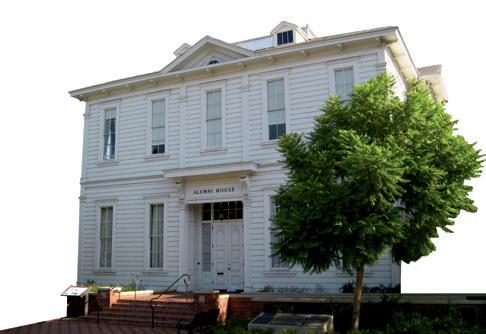
1923 On June 21, shortly after USC’s 40th commencement, a community of alumni, volunteer leaders and USC administrators come together in what is today known as Founders Park to officially establish the General Alumni Association (GAA). While the Alumni Association of the College of Liberal Arts was formed in 1885, the GAA is created for the whole university, and claims more than 4,800 members by 1924. Edward. L. Doheny Jr. ’16 is named the first GAA president, and annual dues are $1.50.
1982 Asian Pacific Support Group (today’s Asian Pacific Alumni Association) is formed.

1990 USC living alumni population hits 200,000.
1976 Ebonics Support Group (today’s Black Alumni Association) is founded.
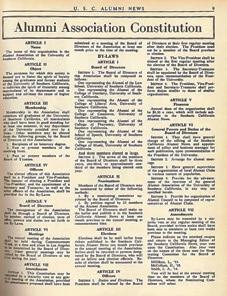
ster USC networking among alumni with professional interests in Asia in business, commerce and education.
The conference is organized by the Office of the USC Provost, USC’s International Offices in Asia and the USC Alumni Association. Trojan Family Day or Trojan Family Weekend is recast as USC’s Parents Weekend for a short time.
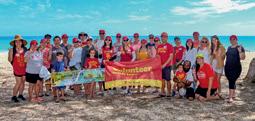
2008
USC living alumni population hits 300,000.
2010 After 34 years of calling the Widney Alumni House home, the USCAA moves its headquarters to the Ronald Tutor Campus Center’s Epstein Family Alumni Center.
2012 Mitchell Lew ’83 MD ’87 becomes first Asian USCAA president. The inaugural USC Alumni Day of SCervice draws more than 1,500 Trojans to participate in 54 community service projects across 18 states and nine



48 usc trojan family Autumn 2023 family news
1924 USC holds its first homecoming on Dec. 5-6 and shuts out Syracuse University 16-0 in the first-ever homecoming game at the Los Angeles Memorial Coliseum. At the time, the Coliseum was just a year old.
1967
Phyllis Norton Cooper’35, LLB ’38 becomes the first GAA woman president.

1972 USC living alumni population reaches 100,000.
1973 Mexican American Alumni Association (today’s Latino Alumni Association) is founded. In 2016, Henry G. Cisneros, former mayor of San Antonio and secretary of the U.S. Department of Housing and Urban Development, called the USC Latino Alumni Association “the most effective, active, robust minority-founded alumni association of any university in America.”
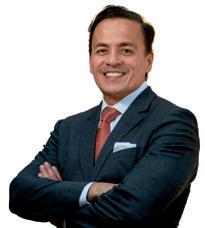
nations. At the time, Katie Kim ’09 said: “The best part of my SCervice Day was knowing that thousands of other USC alumni across the country and beyond were giving back to the community.”
2014
Amy Ross PhD ’86 is named the USCAA’s first LGBTQ+ president.

2017 USC living alumni population hits 400,000.


1925 The alumni magazine, first introduced in 1917 and published intermittently under various names, becomes the
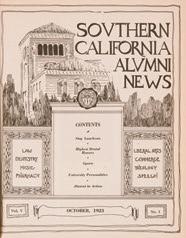
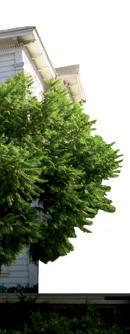
Southern California Alumni Review and publishes until the summer of 1969. After that, USC Trojan Family Magazine — which was first introduced as Trojan Parent in 1968 — expands its coverage to include alumni news.
1927 At the university’s request, the GAA creates USC’s first Bureau of Employment, a job placement office in the Student Union Building for students and alumni. The GAA executive director’s office is next to the USC football coaches’ offices.
1929 GAA kicks off a fundraising drive to build a library and physical education building, but the Great Depression cut short these efforts. Throughout the 1920s and 1930s, the GAA served as the university’s primary fundraiser.
1930 The GAA raises funds and then donates the Trojan Shrine (Tommy Trojan) to USC for the university’s 50th anniversary.
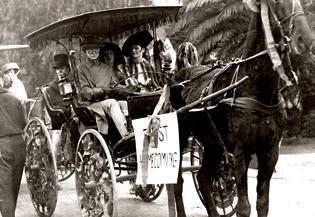
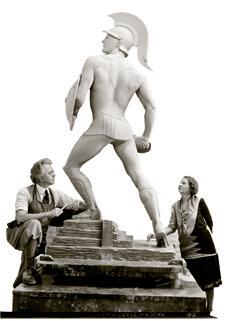
1950 Alumni action saves USC’s Fraternity Row from being razed for the Harbor Freeway extension.
1958 Trojan League of Los Angeles is established.
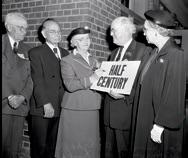
1961 The Alumnae Coordinating Council is founded to encourage interest and participation by all alumnae in university and alumni programs. It provides a forum for USC women’s organizations to connect and share ideas.

2018
2020 USC Career Center and the USCAA launch the Trojans to Trojans Initiative, where new graduates and current students can connect with alumni to get career advice, learn about a field or industry and cultivate professional connections and opportunities by signing up for
1949 Half Century Trojans, the university’s senior alumni group, is founded. Today, it’s one of five alumni association generational programs. The others are Society 53, the student outreach program for current students; Young Alumni (alumni ages 22-35); Second Decade Society (alumni ages 35-45) and Encore Trojans (alumni ages 46-71).
1932 Retired Harvard economist Thomas Nixon Carver (Class of 1891) receives the first Asa V. Call Alumni Achievement Award (named for the 1931-32 GAA president) and kicks off an annual tradition. Subsequent recipients of USC’s highest alumni honor include astronaut Neil Armstrong, opera great Marilyn Horne and screen icon John Wayne.
1935 GAA purchases and donates the land around the new Doheny Memorial Library to USC, a space today known as Alumni Memorial Park.
the Trojan Network, a free online platform. Fight Online!
2023 USCAA celebrates 100 years. Learn more at alumni.usc.edu/alumni100
trojanfamily.usc.edu 49 FULLER, LEW, ROSS AND FELIX PHOTOS BY GUS RUELAS; ALL OTHER PHOTOS COURTESY OF USC ALUMNI ASSOCIATION family news
Michael Felix ’83 becomes USCAA’s first Latino president.
Alumni Raise a Glass
The university honors outstanding Trojans at the 89th Alumni Awards ceremony.
Every April, the Trojan Family gathers in black-tie attire for a formal gala to honor the year’s USC Alumni Awards recipients for their professional achievements and legacy of service. The 2023 gathering was a night filled with friends, family and school spirit as they celebrated seven outstanding alumni.
The university’s most prestigious alumni award recognizes exceptional commitment to USC.
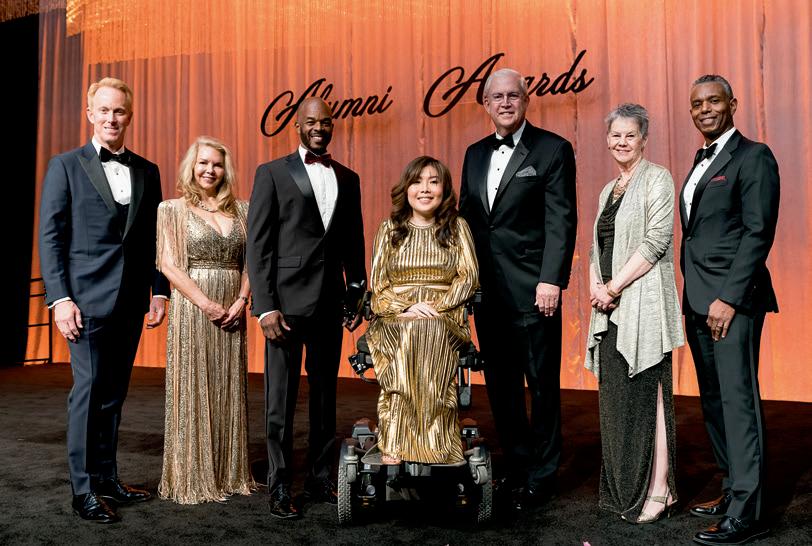
Bill Allen ’79 | former USC trustee and longtime leader in the entertainment industry. Allen is the chairman of FilmLA,
a nonprofit public benefit organization that is the official film office of the city of Los Angeles and Los Angeles County. He was the president and CEO of the L.A. County Economic Development Corp. for 17 years and worked to develop thousands of job opportunities in the region. He was a past president of the USC Alumni Association Board of Governors and is a former member of the Board of Councilors of the USC Rossier School of Education.
ALUMNI MERIT AWARDS
This distinction celebrates accomplishments that reflect the range and quality of a USC education.
Roger Lynch ’93 | CEO of the global media company Condé Nast. A member of the Board of Councilors for the USC Dornsife College of Letters, Arts and Sciences, Lynch also served as president and CEO at other content streaming companies including Pandora, Sling TV, Dish and Video Networks International in the United Kingdom.
Ellisen Shelton Turner ’97 | partner, intellectual property strategist and litigator at Kirkland & Ellis. Turner, who holds multiple leadership roles in California law, regularly supports the Viterbi Summer Institute, a program at the USC Viterbi School of
50 usc trojan family Autumn 2023
ASA V. CALL ALUMNI ACHIEVEMENT AWARD
family news
The 2023 Alumni Awards winners are (from left) Roger Lynch ’93, Teena Hostovich ’86, Donald Dean ’90, Kaitlyn Yang ’11, Bill Allen ’79, Amy Ross ’86 and Ellisen Shelton Turner ’97.
Engineering that supports engineering students from underrepresented backgrounds.
YOUNG ALUMNI MERIT AWARD
This award honors the achievements of an alumnus or alumna aged 35 or younger.

Kaitlyn Yang ’11 | founder, Alpha Studios. Yang, CEO and visual effects supervisor, has more than a decade of industry experience that includes TV shows such as Robot Chicken, Grey’s Anatomy and American Born Chinese. She recently collaborated with other disabled filmmakers to found 1IN4, an intersectional coalition of disabled creatives currently working in Hollywood.
ALUMNI SERVICE AWARDS
This distinction honors alumni’s outstanding volunteering efforts in service to the university.
Donald Dean ’90 | member of the Black Alumni Association Advisory Council and USCAA’s Centennial Advisory Committee. Dean has been an active member on a variety of USC alumni boards; he was a member of the USC Alumni Association Board of Governors and the USC Asian Pacific Alumni Association Board of Directors.
While on the Board of Governors, Dean served on the Executive Committee for four years and with the Black Alumni Association helped to relaunch its “Legacy Through Leadership” mentorship program.
Teena Hostovich ’86 | partner at Lockton Companies and their vice chair of the Pacific; member of the USC Marshall School of Business Board of Leaders. An insurance underwriter for property and casualty securities, Hostovich has served on multiple boards and has been recognized for her work and her leadership. In 2021, she served on the Advisory Transition Committee to U.S. President Joe Biden. For over eight years, Hostovich also served on the USC Marshall School of Business Board of Leaders Executive Committee.
Amy Ross PhD ’86 | USC trustee. At USC, Ross was one of the founding members of what is now USC Lambda LGBTQ+ Alumni Association, which started in 1992. She was president of the USC Alumni Association Board of Governors from 201415 and was elected to USC Board of Trustees in 2015 and to the USC Health Systems Board in 2021. She serves on the USC Arcadia Hospital Board of Directors and is a member of the USC Verdugo Hills Hospital Foundation Board.
Ross was a senior vice president of scientific affairs at Nexell Therapeutics and an associate biologist at the California Institute of Technology. She currently serves as an adviser on the Michelson Prize and Grants Foundation Scientific Advisory Board, and has worked in cancer diagnostics for more than 25 years.
usc trojan family trojanfamily.usc.edu 5151
PHOTOS BY STEVE COHEN; PHOTOS BY BAUMAN PHOTOGRAPHY
family news
The Trojan Marching Band and USC Song perform a highenergy routine to celebrate USC's outstanding alumni.
The 2023 gathering was a night filled with friends, family and school spirit as they celebrated seven outstanding alumni.
Join Us as Homecoming Turns 100!
Come to campus Saturday, November 4, for a special anniversary edition of the ultimate Trojan Family get-together! Celebrate with thousands of alumni, family and friends prior to the USC vs. Washington game at the Coliseum.

And this year, Homecoming is part of another special event: Alumni and Reunion Weekend, taking place November 2-4! With the USC Alumni Association also celebrating its Centennial, we want to honor all USC alumni along with our eight reunion classes: 1973, 1983, 1988, 1993, 1998, 2003, 2008 and 2013.
Find out more at alumni.usc.edu/homecoming.
alumni@usc.edu | @USCAlumni
alumni.usc.edu |
ALUMNI & REUNION WEEKEND
Marta Ruth Elkin Fainberg ’46 (ARC) turned 100 in August. She is fully ambulatory, lives independently, drives and uses a Mac computer.
1 9 5 0 s
Werner P. Koch ’56, ME ’62, DE ’68 (ENG) recently researched and wrote a study in heat transfer from a circular fin and cooling of electrical devices.
Harry Feltman ’57 (BUS) retired at the age of 90 from his own real estate appraisal company in Sedona, Ariz. He patented an ornamental cremation urn and picture frame where the ashes of the deceased are placed in the picture frame.

1 9 6 0 s
Jaak Treiman ’64 (LAS), JD ’67 (LAW)
published Carried by a Magic Fan: Memoir of an Estonian Refugee Family (McFarland Publishing).
1
Mary Burkin ’70 (DRA) appeared this season as Momo in the Actors' Equity Association production of The Humans with the Coachella Valley Repertory Theatre.
Steven Mednick MPA ’75 (SPP), JD ’80 (LAW) was promoted to full professor of clinical entrepreneurship at the USC Marshall School of Business. Mednick joined USC Marshall as an assistant professor of clinical entrepreneurship in 2007.
Judge Bobbi Tillmon JD ’77 (LAW) received the 2022 Aranda Access to Justice Award. The California Lawyers Association presents the award in partnership with the Judicial Council and California Judges Association, and in association with the California Commission on Access to Justice. The Aranda award honors a judge demonstrating a long-term, tireless commitment to improving and promoting fairness and access to the courts, especially for low- and moderate-income Californians.
Robert Wiedower ’79 (SPP) was inducted into the Arizona Veterans Hall of Fame.
Robert L. Handler JD ’79 (LAW) joined Blank Rome LLP’s Corporate, M&A, and Securities group as senior counsel.
1 9 8 0 s
Joan W. Howarth JD ’80 (LAW) published her book Shaping the Bar with Stanford University Press in December 2022.
Mark Lindquist ’81 (SCA) founded a personal injury firm, Mark Lindquist Law, which represents victims in cases against large corporations and the government. He is currently litigating a case against Boeing for the crash of the 737 Max in Ethiopia.
Emil Faithe ’81 (PHM) published his latest self-help book, You Are Sensitive! How to Survive and Thrive in a World That Doesn’t Get You, 2nd Edition
Mark Palmer JD ’83 (LAW) retired from the legal field and has returned to his true love:
history. He launched a podcast in mid-2022 called History Analyzed
Matthew Airey ’84 (LAS) published his second book, Steadfast Awareness 2: Letters and Life’s Takeaways.
Miriam S. Toffelmier ’84 (SPP) was promoted to senior human resources generalist at the University of California, Irvine.
Erin Margaret Schuman ’85 (LAS) received the Brain Prize 2023 from the Max Planck Institute for Brain Research in Frankfurt.

1 9 9 0 s
T R O J A N T R I B U T E
Jim Eddy
Jim Eddy ’52, an extraordinary alumni leader for nearly seven decades, passed away on April 12 at age 92.
Born in Los Angeles, Eddy attended USC as a Naval Reserve Officers Training Corps student. After graduating, he served in the United States Navy as a navigator on an aircraft carrier during the Korean War.
He spent his entire professional career at California Federal Savings and Loan and was an ardent supporter of USC, serving in many Trojan groups. He met his wife of almost 70 years, Janet Ewart '54, MS '78, PhD '91, at USC.

His license plate was “USC DAD,” which he inherited from his father, Arnold Eddy ’24, USC’s longest-standing chief alumni relations officer who served from 1944-1960.
Eddy was a past president of Half Century Trojans, a past USC Alumni Association Board of Governors member, a former chair of the David X. Marks Foundation and most recently was part of the USC Alumni Association’s Centennial Advisory Committee. All four of Jim’s children attended USC in the 1980s, and several of his and Janet’s grandchildren have recently attended USC.

usc trojan family trojanfamily.usc.edu 53 EDDY PHOTO COURTESY OF EDDY FAMILY family class notes 1 9 4 0 s
Gail Wilson Kenna ’65 (LAS) received nine awards at the National League of American Pen Women, Inc. Biennial in Washington, D.C. — the most ever given to one member. 9 7 0 s
Sonya Christian ’90 (LAS) has been appointed as the new chancellor of California's 116-community college system.
What Will Your Trojan Legacy Be?
The former dean of the USC Gould School of Law, Scott Bice ’65, JD ’68 was basically born a Trojan. Both his parents and sister attended USC, so he never seriously considered attending another university. When he and his wife, Barbara, realized how much his education had contributed to their success and happiness, they decided to include the USC Gould School in their estate plan so future generations can have the same opportunity.

To create your Trojan legacy, contact the USC Office of Gift Planning at (213) 740-2682 or giftplanning@usc.edu. Please visit us online at usc.planmygift.org.
“Being a part of an institution and watching it evolve and just get better and better — it was like raising a family.”
Barbara Bice
PHOTO BY ANDRES SANDOVAL
Breaking New Ground
Powerhouse real estate agent and motivational speaker Tracy Tutor refuses to accept inequity based on gender.
An alumna of the USC School of Dramatic Arts and member of the school’s Board of Councilors, Tracy Tutor is a powerhouse real estate agent at Douglas Elliman Beverly Hills and was named one of “Hollywood’s Top 30 Real Estate Agents in 2022” by The Hollywood Reporter. She is an author, advocate against discrimination, motivational speaker and the first — and only — female real estate broker to be featured on the Bravo reality show Million Dollar Listing Los Angeles .
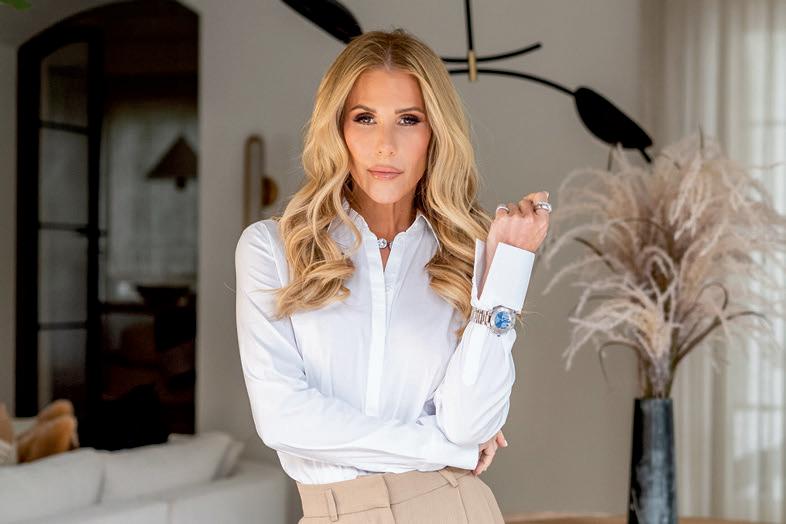
“Any kind of discrimination in school and business is against everything I believe in,” Tutor says, adding that she speaks about civil rights and discrimination in her motivational talks consistently. “It’s incredibly important — and I think we could be doing more.”
SUCCESSFUL, COMPETITIVE, SMART, FUNNY
“What still exists today,” Tutor says, “is the old-school way of thinking that if we want to be successful, if we want equal wages, we have to somehow do it within
the [traditional] confines of how this world works. And that’s short-sighted.”
Women, Tutor says, can be successful, competitive, smart — and funny. “Everyone should feel free to be who they are,” she says. She conveys that message in her book, Fear is Just a Four-Letter Word: How to Develop the Unstoppable Confidence to Own Any Room , written for a younger generation of women entrepreneurs and her two teenage daughters.
Tutor counts Oprah Winfrey and Ellen DeGeneres as boundary-breaking role models, but her assurance as a businesswoman came from her father: USC alum Ronald Tutor, owner of the Sylmar-based Tutor Perini Corp., one of North America’s largest general contracting firms. Her father is also a Life Trustee of the USC Board of Trustees, with two buildings named after him on the University Park Campus: Ronald Tutor Campus Center and Ronald Tutor Hall.
“A first-generation Armenian American, he fought for everything he had t o build
the American dream,” Tutor explains. “As a child, watching him work his tail off was a big part of the beginning of my confidence.”
FROM HOLLYWOOD — AND BACK
Tutor’s career path switch from acting to real estate came after she graduated with a theater arts degree and briefly worked as an actor in Hollywood. She recognized that the chances of success and financial independence in that world were a long shot. “I wanted to control my own life, make decisions for myself and not lean on my family for financial support,” she says.
About nine years ago, Tutor was recruited by Douglas Elliman Development Marketing, a company helmed by two women she considers mentors: Susan de França, president and chief executive officer, and Dottie Herman, now Douglas Elliman vice chair emerita.

At Douglas Elliman, Tutor says she feels supported. In fact, Herman was the first to tell her she belonged in front of the camera. “She sat me down and said, ‘You could represent women in real estate on so many different levels.’”
A year and a half later, Tutor was offered her Bravo show. “That was a full-circle moment, being in front of the camera again after leaving Hollywood at 21 years old.” LYNNE
HEFFLEY
usc trojan family 55 A L U M N A P R O F I L E T R A C Y T U T O R
trojanfamily.usc.edu
Erikaanne Endrijonas ’90 (LAS), ’96 (LAS) was selected as the next superintendent/ president of Santa Barbara City College by the Board of Trustees.
Mike Ludwig BS ’91 (ENG), JD ’94 (LAW) recently launched Ludwig Mediation – Ludwig Law PC, an independent employment law mediation practice.
Alison Dundes Renteln JD ’91 (LAW) received the Albert S. Raubenheimer Award from the USC Dornsife College of Letters, Arts and Sciences. The award recognizes excellence in teaching, research and service. Renteln also co-authored International Human Rights: A Survey (Cambridge University Press, 2023), and co-edited The Ethical University: Transforming Higher Education (Rowman & Littlefield, 2023).
Victor Romero JD ’92 (LAW) was appointed interim dean of Penn State Law and the Pennsylvania State School of International Affairs.
Millicent Borges Accardi ’93 (LAS) wrote Quarantine Highway published by FlowerSong Press.
Mark Foster BA ’94 (LAS), JD ’98 (LAW) was appointed executive vice president and general counsel of American Healthcare REIT, Inc.
Nancy Yaffe JD ’95 (LAW), partner at Fox Rothschild LLP, was named to the Los Angeles Business Journal’s Leaders of Influence: Labor & Employment Attorneys list.
Karen Zarsadiaz-Ige ’98 (LAS/SCJ) is the communications manager for the Los Angeles County Fire Department, where she created “Sirens of Silence,” an award-winning autism and special needs awareness and inclusion program for first responders and the community. She also spearheaded a permanent, specially painted “Sirens of Silence” lifeguard tower on Torrance Beach to promote kindness and embrace all abilities.
Zee Ahmedani JD ’98 (LAW) joined Allen & Overy LLP as a pvartner in the firm’s global funds practice.
Silvia Maier ’99 (LAS), ’01 (LAS) has been appointed academic director of the Center for Global Affairs, School of Professional Studies, New York University.
Isaiah Weedn ’99 (BUS), JD ’03 (LAW) was named Sheppard, Mullin, Richter & Hampton LLP’s director of litigation training. He has been an associate and special counsel in Sheppard Mullin’s Business Trials Practice Group since 2006.
2 0 0 0 s
Juanita E. Mantz JD ’02 (LAW) authored Portrait of a Deputy Public Defender (or, How I Became a Punk Rock Lawyer) (Bamboo Dart Press), which won Best First Book-NonfictionEnglish in the Mariposa category at the 2022 International Latino Book Awards.
Marisa Murillo JD ’02 (LAW) was named to the 2022 Notable Women in Law list in Crain’s Chicago Business.
Mandana Dayani BA ’03 (LAS), JD ’07 (LAW) published an article titled, “I’m a Voter. You Should be One, Too” in Harper’s Bazaar.
Efrain Escobedo ’03 (LAS) has been named president and chief executive officer of the Center for Nonprofit Management, an organization bridging Southern California's public, private, and nonprofit sectors to drive positive change in the community.
Tara Canady Doss JD ’03 (LAW) was promoted to supervising administrative law judge in the Special Education division of the California Office of Administrative Hearings.
T R O J A N T R I B U T E
Christopher Smith
Christopher Smith, clinical professor of communication and founder of the Media, Economics & Entrepreneurship (M{2e}) program, passed away in May at age 55. A devoted scholar, teacher and mentor at the USC Annenberg School for Communication and Journalism for more than 20 years, Smith inspired colleagues and students to innovate and lead through his trailblazing courses and collaborations with organizations at the vanguard of an ever-changing media landscape.
Smith developed a wide range of inventive curricula, including “Communication, Culture and Capitalism” and “Media, Money and Society,” as well as first-of-their-kind seminars in witnessing,
trauma and testimony and the business of popular culture and entertainment. He also leveraged USC Annenberg’s alumni network of notable senior executives in the media industry to create and drive unique opportunities for students to conduct original research projects, and to help solve real-world business cases at media companies, including NBCUniversal, Amazon and Roku.
“Chris was deeply committed to his students, helping them acquire the skills to adapt to and engage with the tectonic shifts in the media industry,” said Willow Bay, dean of USC Annenberg.
Ernest Wilson, former dean and current professor of communication, added, “[Smith] combined great personal warmth and consideration with that rare capacity of powerful truth-telling about things that mattered.”

56 usc trojan family Autumn 2023
PHOTO COURTESY OF SALAAM COLEMAN SMITH family class notes
Grace Notes
Jazz pianist Donald Vega ’99 talks about working on a very personal album — and his Guggenheim Fellowship in Music Composition.
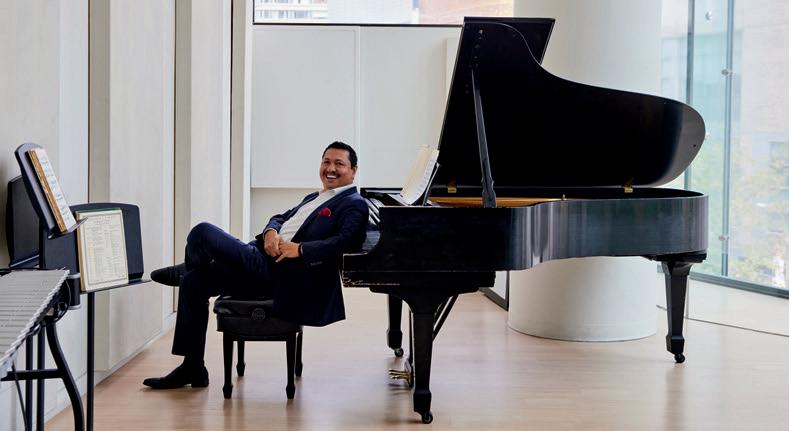
An accomplished jazz pianist, composer and instructor with multiple recorded albums released in the past 20 years, Donald Vega ’99 is preparing to release his most introspective collection of songs, As I Travel, on Oct. 27.
Recorded with several Grammy Awardwinning musicians, the album is funded in part by the 2023 Guggenheim Fellowship that Vega recently received. The award recognizes his talent, helps to further his research and supports his work within the field.
As a composer, he says that most often the melodies just come to him. “Sometimes, they come complete and I’m able to write everything down,” he says. “Or it comes only as an idea. So, I let it rest and later develop it. I’m just trying to figure out what sounds like me.”
As he reflects on the immense challenges he’s navigated and opportunities seized while nurturing his talent, he says: “I call my personal journey a miracle.” Growing up in a musical family in Nicaragua, he was able to play by ear at 3 years old and began classical piano training when he was 8. However, political conflict in his home country caused his mother to immigrate to the United States, and four years later, 14-year-old Vega joined her. His passage across the border was precarious but successful — one of the miracles, he says — and they both were granted political asylum and settled in Los Angeles, not far from USC.
Without a piano of his own, Vega practiced on the Crenshaw High School choir room’s piano, rather than eat lunch. At home, he says, “I loved the music so much that in my mind I saw the piano, and I could ‘play’ it on the wall.”
His self-discipline and innate talent brought many accolades, including The Music Center’s Spotlight program, where he won $5,000 and was gifted a piano by the late piano dealer David Abell. The award also connected him with philanthropist and benefactor Helen Bing, who supported another need that Vega had.
Born with a cleft palate that affected his hearing, Vega had numerous surgeries, the first just days after birth. As he got older, the earaches grew more worrisome. “You can imagine that I’m a musician, and I couldn’t hear — it got to the point that I was reading lips,” he says. Bing facilitated the advanced medical treatment to greatly improve his hearing.
While living in South Central L.A., Vega studied at The Colburn School and was also welcomed by the storied musical art space The World Stage in Leimert Park Village. “A lot of my Leimert Park friends were going to USC,” he says, so he knew where he was headed. After Vega enrolled, he found that the university’s reputation for music instruction lived up to the hype.
“The faculty were my mentors, including John Clayton, Shelly Berg, John Thomas and Neal Desby,” Vega says. “All these people really shaped me.” One of the highlights during his school years was playing for Quincy Jones’ birthday.
His USC and jazz musician families also stood with him when the laws changed for those granted political asylum from Nicaragua. “I was facing deportation, but I had a lot of support from the USC faculty and fellow musicians,” Vega recalls. “They all wrote letters, including Quincy Jones. So, that was incredible. I got the help I needed, and I was able to get residency, and later, I became a citizen.” He went on to earn a master’s at the Manhattan School of Music and an artist diploma at the Juilliard School in New York where he is now an instructor.
The most intimate of his many recordings, As I Travel, reflects this life story. “The goal of an artist is to be vulnerable, to be free and able to talk about yourself,” says Vega, who is headed to Japan in November to tour with his Donald Vega Trio. “I’ve done that a little bit in all my recordings, but this time, I’m ready to show who I am.”
LAURIE MCLAUGHLIN
usc trojan family trojanfamily.usc.edu 57 A L U M N U S P R O F I L E D O N A L D V E G A ’ 9 9 PHOTO
BY WINNIE AU
Donald Vega ’99 sits at a piano at the Juilliard School in New York City, where he teaches. His latest album, As I Travel , is set for release on Oct. 27.
Football’s More Fun with a Crowd!
And if you can’t make it to the Coliseum, then celebrate USC’s final Pac-12 season with your local Trojan Family! Each fall, alumni worldwide host Game Watch Parties in their communities, so cheer along with Trojans near you by finding a Game Watch at alumni.usc.edu/gamewatch.

Plus, if you want to join us on the road to catch an away game in person, we still have two Weekenders remaining: Cal (October 28) and Oregon (November 11). Visit alumni.usc.edu/weekenders today!

2023
@USCALUMNI | ALUMNI.USC.EDU | ALUMNI@USC.EDU
Denise Hippach JD ’03 (LAW) was appointed by Gov. Gavin Newsom to serve as judge of the Santa Barbara County Superior Court. She is the first African American woman to serve on the bench in Santa Barbara County.
Scott Alan Burroughs JD ’04 (LAW) and Stephen M. Doniger JD ’95 (LAW), who co-own Doniger/Burroughs, prevailed at the Supreme Court of the United States earlier this year, winning a 6-3 decision in the copyright case Unicolors, Inc. v. H&M Hennes & Mauritz, L.P.
Daniel Ahn JD ’04 (LAW) recently joined Reed Smith LLP as a partner in the firm’s Global Regulatory Enforcement practice group. He previously served for 10 years as a deputy chief, acting chief and senior litigation counsel at the U.S. Attorney’s Office for the Central District of California.
and Employment Practice’s Employment Litigation & Trials group.
Joshlyn R. Pulliam JD ’05 (LAW) has been appointed as a judge in the Riverside County Superior Court.
Ava Chin PhD ’06 (LAS) wrote Mott Street: A Chinese American Family's Story of Exclusion and Homecoming , published by Penguin Press.
Star Mishkel Tyner JD ’06 (LAW) was promoted to partner at Felker Toczek Suddleson Abramson McGinnis Ryan LLP. She negotiates television and film deals on behalf of actors, directors, writers, showrunners and producers.
Michelle Commander ’07, PhD ’10 (LAS) was named deputy director of the Smithsonian National Museum of African American History and Culture.
Jeff Sklar JD ’07 (LAW) was appointed by Gov. Doug Ducey as a judge in Division 2 of the Arizona Court of Appeals.
Jennifer Dunphy ’08 (LAS) published Don’t Tell Me What To Do, a book about female empowerment.
Sheldon Evans ’08 (LAS) was appointed a professor of law at Washington University in St. Louis, Mo.
Carolynn Beck JD ’09 (LAW) joined Eisner LLP as partner in New York.
Her practice is focused on helping residential, commercial and industrial developers and companies navigate all phases of the land use entitlement process in Oregon and Washington.
Laura Riley JD ’10 (LAW) is the new director of clinical programs at University of California, Berkeley School of Law.
Jaysen S. Chung JD ’11 (LAW) was promoted to partner at Gibson, Dunn & Crutcher LLP. Chung focuses on patent and appellate litigation and has extensive experience in a diverse range of industries, including pharmaceuticals, biotechnology, artificial intelligence and virtualization technologies.
Amy Proctor JD ’11 (LAW) , of Irell & Manella LLP; Michael Davis JD ’11 of Greenberg Traurig, LLP; and Alexander James Merton JD ’11 of Quinn Emanuel Urquhart & Sullivan LLP, were recognized in Bloomberg Law’s “40 Under 40” 2022 list.
Lucas Quass JD ’11 (LAW) has been promoted to counsel at Latham & Watkins LLP’s Orange County office in Costa Mesa, Calif. A member of the Environment, Land & Resources practice and Corporate department, Quass is a transactional and litigation lawyer who helps clients secure water rights and supplies as well as obtain and defend land use and environmental approvals for infrastructure, energy and development projects.
M. Beaumont Shapiro ’05 (LAS) joined the Skirball Cultural Center as the institution’s inaugural rabbi.
Nanette D. Barragán JD ’05 (LAW) was elected as the new chair of the Congressional Hispanic Caucus, a legislative service organization of the U.S. House of Representatives.
Lindsay Hutner JD ’05 (LAW) is co-editor of a new treatise published by the Practising Law Institute titled “California Employment Law” and co-authored the treatise chapter covering gender discrimination. Hutner is co-chair of Greenberg & Traurig LLP’s Labor
Bosco Yuen ’09 (ACC, BUS) became a partner in risk advisory at Baker Tilly International, the ninth-largest certified public accountant advisory firm in the world.
2 0 1 0 s
Trevor Countryman BA ’10 (LAS), JD ’13 (LAW) was elected partner at Jeffer Mangels Butler & Mitchell LLP.
Allison Reynolds JD ’10 (LAW) was promoted to partner at Stoel Rives LLP. She is a member of the firm’s Environment, Land Use & Natural Resources group.
Natalie Hardwick Rao JD ’11 (LAW) has been promoted to counsel at Latham & Watkins LLP in Washington, D.C. A member of the White-Collar Defense & Investigations practice and Litigation & Trial department, she advises clients on white-collar criminal defense, government and internal investigations, and complex civil litigation.
Brandon Reilly JD ’11 (LAW) was elected equity partner in the Orange County office of Manatt, Phelps and Phillips, LLP.
Chloe S. Wolman, JD ’11 (LAW) started Wolman Law, her own boutique family law practice. Wolman handles complex

usc trojan family trojanfamily.usc.edu 59
family class notes
HIGH SCHOOL STUDENTS: STUDY AT USC
Take online courses from USC faculty and industry experts from anywhere in the world in business, marketing, filmmaking, computer science and more. Start dates are year-round.
precollege.usc.edu
custody and divorce matters as well as mediation counseling and pre- and post-marital agreements.
Jenny Morgan MAT ’12 (EDU) wrote The Wondrous Adventures of Julie O’Day , available at thewondrousadventures.com.
Danielle Willenborg MSW ’12 (SSW) was promoted to director of the San Diego Vet Center where eligible veterans are provided readjustment counseling to help them make a successful transition from military to civilian life.
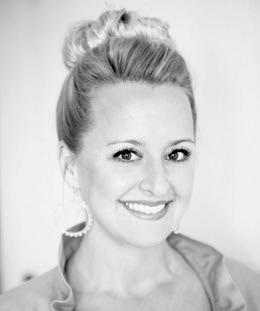
Meghan Grim JD ’13 (LAW) joined the Los Angeles County Counsel’s Office as deputy county counsel in the dependency trial division. She also recently welcomed a baby boy.
Ximeng Guo LLM ’13 (LAW) started a new position as legal officer for the United Nations Office of Legal Affairs in New York City.
Cynthia E. Organ JD ’13 (LAW) was promoted to partner in Glaser Weil, LLP’s litigation department.
Jazmine Kwong ’14 (LAS) returned to Keck Medicine of USC as a facial plastic and reconstructive surgery physician assistant specializing in nonsurgical procedures.
Olivia Levenson ’14 (SCA) presented her work on web-based augmented reality and gamification at the Education Innovation Challenge in Harvard University. She
COME EXPLORE. BE INSPIRED. FIND YOUR FUTURE.
Autumn 2023
family class notes
combines storytelling, cinematic techniques and innovative technology to empower, support and emotionally connect with children on healing journeys.
Marie de la Lanne LLM ’15 (LAW) was promoted to senior data protection counsel at Telefónica Germany.
Kelsey McGregor JD ’15 (LAW) has joined the USC Gould International Human Rights Clinic for six months as a senior supervising attorney. McGregor is counsel at WilmerHale in Los Angeles and was awarded their prestigious Pickering Fellowship.
Sam Brown JD ’15 (LAW) was named partner at Hennig Kramer Ruiz & Singh LLP, where he practices plaintiff’s side employment law, civil rights law, and litigates false claims act cases.
Joshua Ashish Dawson ’16 (ARC) was profiled in The New York Times for his short film Denervation, about global health and the environment.
Valarie Johnson MPH ’16 (MED) has been elected to the Grosse Pointe Public School System Board of Education.
Mili Davé LLM ’17 (LAW) was elevated to agent in WME’s brand partnerships division where she builds WME’s footprint across Europe, the Middle East and Asia.
David Joseph Giardino ’18 (LAS) was promoted to senior director of marketing strategy at NBCUniversal.
Jamie Kwong ’18 (LAS), ’18 (ANSC) was accepted into the Council on Strategic Risks’s Nuclear Risk Reduction Fellowship Program.
2020 s
Jennifer Blewett, DSW ’20 (SSW) was named a Diplomate in Clinical Social Work by the National Association of Social Work. This is the highest credential level available to social workers. She is currently a clinician and the assistant director for community outreach and engagement in the department of
psychiatry at Massachusetts General Hospital. She also has a private psychotherapy practice in Boston.
Simon Luu ’21 (LAS) was honored as a 20222023 Wilson Sonsini Foundation Diversity Scholar at the California ChangeLawyers Next Gen Awards.
Sara Zollner JD ’21 (LAW) joined Weinberg, Roger & Rosenfeld as an associate working on arbitrations, litigation and National Labor Relations Board hearings.
Robert Mb. Flak ’21 (EDU) was promoted to Army Master Sergeant/E-8 in June. He was selected for a position within the Headquarters of the Army G-1 at the Pentagon to serve on the staff of the Army’s newly minted Integrated Personnel and Pay System as a functional capability manager.
Niyati Shah LLM ’22 (LAW) joined Prime Video & Amazon Studios as
a legal consultant in their Originals (India) Division.
Jacquie Baly EdD ’24 (EDU) is the president of BalyProducts and an adviser to Texas Gov. Greg Abbott on higher education initiatives. She was inducted into the Texas Women’s Hall of Fame in 2022.
BIRTHS
Imran Chaudhry, ’99 (ENG) , a son, Rahman Nisar Chaudhry.
Elisabeth Davis Hakes ’18 (EDU) and Glenn Hakes, a son, Davis Allen.
Shelby Dale DeWeese ’15 (LAS) and Joseph DeWeese ’15 (LAS) , a daughter, Rory Grace.
Robert Mb. Flak ’21 (EDU) , a daughter, Amelia J. Flak.
TROJAN TRIBUTE C.R. Roberts
Former USC fullback C.R. Roberts, best known for his legendary 1956 performance against Texas that broke through racist barriers, died on July 11 in Norwalk, Calif., of natural causes. He was 87.
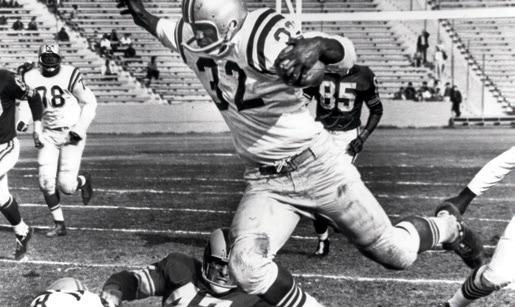
In Troy’s historic 44-20 victory over Texas in 1956, Roberts rushed for 251 yards, setting the USC single-game rushing record in the process. That record stood for 20 years. The game was played in Austin, Texas, and upon arrival, the team tried three different hotels before finally finding one that would break the rules and allow its Black players to stay.
Lettering from 1955-56, Roberts earned All-Pacific Coast Conference in 1956, as he led the conference in rushing with 775 yards on 120 attempts. He also assisted in USC's defensive efforts and led the Trojans with 67 tackles and 6 pass deflections in 1956. He also was the kick return leader on special teams with 9 attempts for 234 yards (26.0 avg) and 1 touchdown. He had three 100-yard rushing performances in his career. Roberts also competed on the Trojans’ 1957 track team. He played in the Canadian Football League, and was with the San Francisco 49ers in the NFL from 1959-62. He then worked as a high school teacher and administrator, and also started a tax consulting business. Roberts was named to the USC Athletics Hall of Fame in 2007.
usc trojan family trojanfamily.usc.edu 61
PHOTO COURTESY OF USC ATHLETICS
Carlos H. Reynales ’46 (BUS) of Long Beach, Calif.; Aug. 31, 2021, at the age of 99.
Warren G. Brown ’46 (DEN) of Camarillo, Calif.; Dec. 13, 2022, at the age of 100.
Joseph Digati Gullo ’51 (LAS) of Tucson, Ariz; April 18, 2023, at the age of 102.
Terrence Taylor ’51 (LAS), ’55 (MED) of Laguna Beach, Calif.; March 7, 2023, at the age of 95.

Bob G. Gardenhire ’52 (PHM) of Cambria, Calif.; March 15, 2022, at the age of 94.
James C. Frampton ’53 (SCJ) of San Diego, Calif.; Aug. 28, 2022, at the age of 89.
E. Robert Wallach ’54 (LAW) of San Francisco, Calif.; May 15, 2022, at the age of 88.
Jerry Philip Andes ’56 (LAS) of Fullerton, Calif.; Jan. 3, 2023, at the age of 88.
Donald Lockwood Burge ’56 (LAS) of Monrovia, Calif.; March 23, 2023, at the age of 88.
Jerome Schneider ’56 (PHM) of Westlake Village, Calif.; May 8, 2023, at the age of 92.
Norman Gregory Taylor ’57 (LAS) of Porter Ranch, Calif.; March 25, 2023, at the age of 88.
William Lloyd Hitt ’59 (PHM) of Sunland, Calif.; Nov. 5, 2022, at the age of 90.
John Fischook ’61 (LAS) of Mississauga, Canada; Feb. 21, 2023, at the age of 83.
Marietta Kin ’61 (LAS) of Tustin, Calif.; April 14, 2023, at the age of 83.
George Robert Marsh ’61 (DEN) of San Francisco, Calif.; April 10, 2023, at the age of 85.
H. Frederick Schug MSW ‘62 (SSW) of Olympia, Wash; April 19, 2021, at the age of 94.
Stuart Barton ’63 (MED) of Palm Springs, Calif.; Nov. 29, 2022, at the age of 84.
Stanley Tobias MD ’63 (MED) of Los Angeles, Calif.; Nov. 24, 2022, at the age of 87.
Phillip Cohl ’64 (LAS) of Arroyo Grande, Calif.; Jan. 24, 2022, at the age of 79.
Terence Lynch ’64 (LAS) of Pasadena, CA; Jan. 23, 2023, at the age of 81.
Neal Moore ’67 (LAS), ’71 (LAW) of Cerritos, Calif.; Oct. 17, 2022, at the age of 77.
Gail Fosler ’69 (LAS) of Chevy Chase, MD; April 2, 2023, at the age of 75.
62 usc trojan family Autumn 2023 family class notes I N M E M O R I A M - A L U M N I
Join the L.A. Coliseum’s epic 100-year legacy by personalizing your brick today! REGGIE BUSH | USC TROJAN (2003–2005) COLISEUMLEGACY.COM BUILD YOURS AT THE L.A. COLISEUM
Ross S. Selvidge ’69 (ARC), MS ’74 (GRD), PhD ’85 (GRD) of Pasadena, Calif.; Sept. 30, 2022, at the age of 76.
Andy R. Bazar MS ’71 (ENG) Rancho Cucamonga, Calif.; Jan. 12, 2023, at age 83.
Judy Chirlin ’74 (LAW) of Los Angeles, Calif.; Nov. 11, 2022, at the age of 74.
Richard William Ormond MBA ’77 (BUS) of Notre Dame, Ind.; April 13, 2023, at 70 years old.
Wendell H. Sawyer ’77 (LAS) of Corona del Mar, Calif.; Jan. 3, 2023, at the age of 83.
Jo Ann Okimoto Chinn ’77 (LAS) of Honolulu, Hawaii; Jan. 24, 2023, at the age of 67.
Marcia Goldstein, MS ’79 (GRN) , of Laguna Woods, Calif.; Oct. 19, 2021, at the age of 79.
Cheryl Destro, MSW ’82 (SSW) of Costa Mesa, Calif.; Nov. 12, 2022, at the age of 68.
David Berry JD ’83 (LAW) of Culver City, Calif.; Oct. 3, 2022, at the age of 66.
Kathleen M. White JD ’84 (LAW) of Monterey, Calif.; July 31, 2022, at age 68.
William Joel Hart Jr. ’85 (LAS), MPW ’86 (LAS) of Montrose, Calif.; Feb. 11, 2023, at the age of 78.
Heather Gray JD ’96 (LAW) of Los Angeles, Calif.; July 30, 2022, at age 50.
Eleu Kamakanoe Ornellas ’96 (LAS) of Honolulu, Hawaii; Feb. 23, 2023, at the age of 48.
Andrea Lynn Kushner JD ’97 (LAW) of Manhattan Beach, Calif.; Oct. 18, 2022, at age 51.
ACC USC Leventhal School of Accounting
ARC USC School of Architecture
ART USC Roski School of Art and Design
BPT Division of Biokinesiology and Physical Therapy
BUS USC Marshall School of Business
DEN Herman Ostrow School of Dentistry of USC
DNC USC Kaufman School of Dance
DRA USC School of Dramatic Arts
EDU USC Rossier School of Education
ENG USC Viterbi School of Engineering
GRD USC Graduate School
GRN USC Leonard Davis School of Gerontology
IYA USC Iovine and Young Academy
LAS USC D ornsife College of Letters, Arts and Sciences
LAW USC Gould School of Law
MED Keck School of Medicine of USC
MUS USC Thornton School of Music
OST USC Chan Division of Occupational Science and Occupational Therapy
PHM USC School of Pharmacy
SCA USC School of Cinematic Arts
SCJ USC Annenberg School for Communication and Journalism
SPP USC Price School of Public Policy
R O J A N T R I B U T E Amy Alderfer
Amy Alderfer JD ’99 (LAW), passed away on May 3, 2023, following a battle with cancer.
A long-standing volunteer at the law school and USC, Alderfer served as the president (2018-2022) and secretary of the USC Gould Alumni Association and member of the Los Angeles Committee. She also served as a member of the USC Alumni Association Board of Governors and the USC Gould Board of Councilors. In 2021, she was honored with the USC Alumni Association’s Widney Alumni House Volunteer Award for outstanding service to the USC community.
An accomplished litigation attorney, Alderfer was a partner in the Santa Monica office of the Cozen O’ Connor law firm and an associate at Greenberg Traurig, LLP. In 2021, she secured her dream job as principal attorney for The Walt Disney Company, which she held at the time of her passing.

She is survived by her husband, Jamie Bernald JD ’99 (LAW); sons, William and Ryan; parents, John and Barbara Alderfer; brother, Kevin Alderfer and sister, Karen Alderfer.
Nicholas Wolpe Stadmiller ’05 (LAW) of Los Angeles, Calif.; May 20, 2020, at age 41.
Patrick Santos ’06 (LAS) of Holbrook, NY; Feb. 28, 2023, at the age of 40.
Luke Schunk ’14 (LAS) of Salt Lake City, Utah; April 2, 2023, at the age of 32.
SSW USC Suzanne Dworak-Peck School of Social Work
Chloe Barker, Julie Tilsner, Crisann BegleySmith, Landon Hall, Jane Ong, Tatiana Overly, Alex Rast, Justin Wilson, Leticia Lozoya, Katie Maloney, Maeve Harding and Elliott Scher contributed to this section.
June McPherson House of Houston, Texas; May 31, 2023, at the age of 78.
Dean H. Mayer of Tacoma, Wash.; Feb. 12, 2022, at the age of 96.
usc trojan family trojanfamily.usc.edu 63 family class notes
F A C U L T Y A N D F R I E N D S
L E G E N D
T
PHOTO COURTESY OF USC GOULD
For the Women of Troy
New Rawlinson Stadium set to be home of USC women’s soccer and lacrosse. BY
USC women’s soccer and lacrosse programs will have their own state-of-the-art stadium to call home in 2025 upon the completion of Rawlinson Stadium, thanks to a $10 million gift from the Fritz B. Burns Foundation.

“Rawlinson Stadium will be the place for the Women of Troy to dazzle us with their athletic prowess even more,” USC President Carol L. Folt said. “I love making this announcement during a milestone year: the 50th anniversary of Title IX. USC’s commitment to women in sports is stronger than ever.”
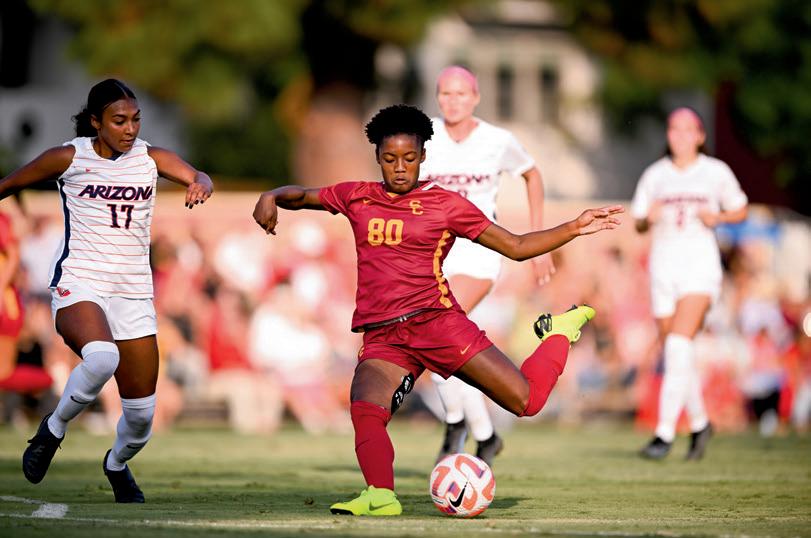
The $38 million project, which will begin by the end of 2023, replaces and expands upon Soni McAlister F ield, the current home of USC women’s lacrosse and soccer.
The new stadium is part of Folt’s “moonshot” for athletics — a major effort to prioritize university excellence in athletics with upgraded facilities, support and philanthropy that will cut across a variety of sports programs. Folt has long focused on improvements for student-athletes, including moving their health care to the Keck Medicine of USC system, expanding financial aid
GRAYSON SCHMIDT
and ensuring academic support — all aimed at a student-centric approach for athletes.
Rawlinson Stadium will feature an elite natural grass playing surface with a total capacity of 2,500 — including spectator viewing decks and social spaces, a state-of-the-art press box, spectator restrooms, a box office, concession stands and a formal entry plaza.
It will also have new, dedicated locker rooms for the soccer and lacrosse teams, as well as a team meeting area, sports medicine space, nutrition fueling bar and a meeting space for coaches. The field itself will feature an LED video board, stadiumwide audio system and field lights.
For junior forward Simone Jackson, the news is the perfect way to show the university’s support for women’s athletics.
“I am so excited to hear we are investing in women for generations to come,” Jackson said. “I am beyond proud to be a part of this time, and I hope to inspire many more girls when my team plays on a field made just for the Women of Troy.”
PHOTO BY KATIE CHIN/USC ATHLETICS
64 usc trojan family Autumn 2023 fight onward Have an idea for an imagined vision of USC? Email it to magazines@usc.edu.
GREATNESS. TOGETHER.
No matter what dreams you may have on the horizon, our expert health care team is here to partner with you to realize your potential. When you review your insurance options this Open Enrollment season, select a network that includes the award-winning care of Keck Medicine of USC. Together we are limitless.

Keck Hospital of USC
USC Arcadia Hospital
USC Care Medical Group
USC Norris Cancer Hospital
USC Verdugo Hills Hospital
KeckMedicine.org © 2023 Keck Medicine of USC
Open Enrollment starts SOON!
One of the noisemakers from the party had made its way onto my desk. But my brother-in-law and I were too occupied by the paperwork stacked in front of us to notice. Just a few weeks earlier, our father-in-law had passed. While most people were celebrating the New Year, we were trying to settle his estate under a time crunch. Unsure if he would return our call at such a late hour, we phoned his advisor Matt, who not only took the call, but put his own celebration on hold while helping us through the process. We were so impressed by his responsiveness, we moved our own accounts to Whittier Trust. We started our new year with peace of mind and an appreciation of the little things.


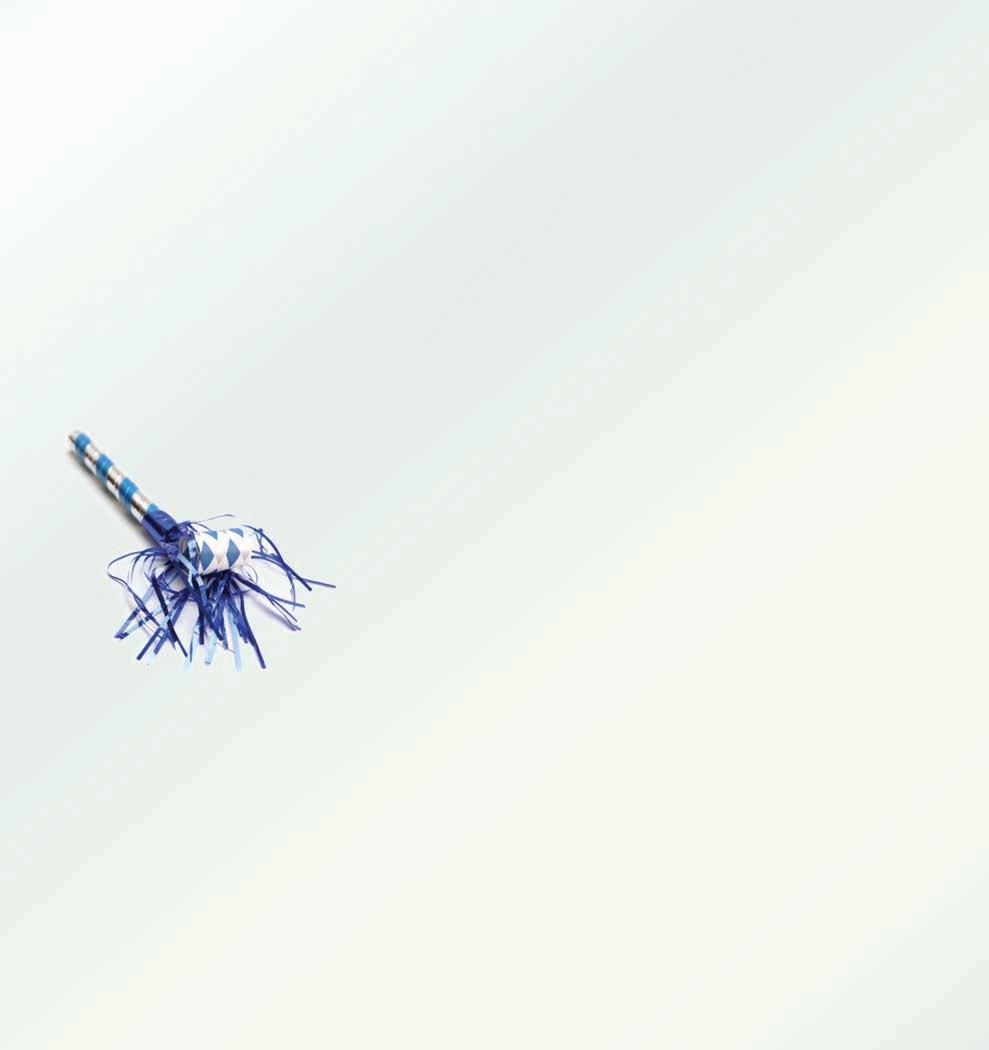
Haley, San Jose

Even though he missed the countdown, he never dropped the ball.
$10 MILLION MARKETABLE SECURITIES AND/OR LIQUID ASSETS REQUIRED. Investment and Wealth Management Services are provided by Whittier Trust Company and The Whittier Trust Company of Nevada, Inc. (referred to herein individually and collectively as “Whittier Trust”), state-chartered trust companies wholly owned by Whittier Holdings, Inc. (“WHI”), a closely held holding company. This document is provided for informational purposes only and is not intended, and should not be construed, as investment, tax or legal advice. Past performance is no guarantee of future results and no investment or financial planning strategy can guarantee profit or protection against losses. All names, characters, and incidents, except for certain incidental references, are fictitious. Any resemblance to real persons, living or dead, is entirely coincidental. Investment Management & Consulting | Trust Services | Family O ce Philanthropy & Family Continuity | Real Estate CONTACT TIM MCCARTHY | 626.463.2545 | WHITTIERTRUST.COM USC Trojan Family Magazine University of Southern California Los Angeles, CA 90089-2818 Change Service Requested NON-PROFIT ORGANIZATION U.S. POSTAGE PAID UNIVERSITY OF SOUTHERN CALIFORNIA












































 BY ADAM SMITH • ILLUSTRATION BY RAYMOND BIESINGER
BY ADAM SMITH • ILLUSTRATION BY RAYMOND BIESINGER


 BY ADAM SMITH • ILLUSTRATIONS BY YUTA ONODA
BY ADAM SMITH • ILLUSTRATIONS BY YUTA ONODA

























































